Important: Some parts of the bike packaging function as a bike stand and facilitate the assembly process. In order to ensure an easy assembly, only remove packaging when told to do so in the following instructions.
1. Remove and set aside items:
Comfort 2 Assembly Guide
The 4 Major Steps to Getting Your Bike Ready to Ride:
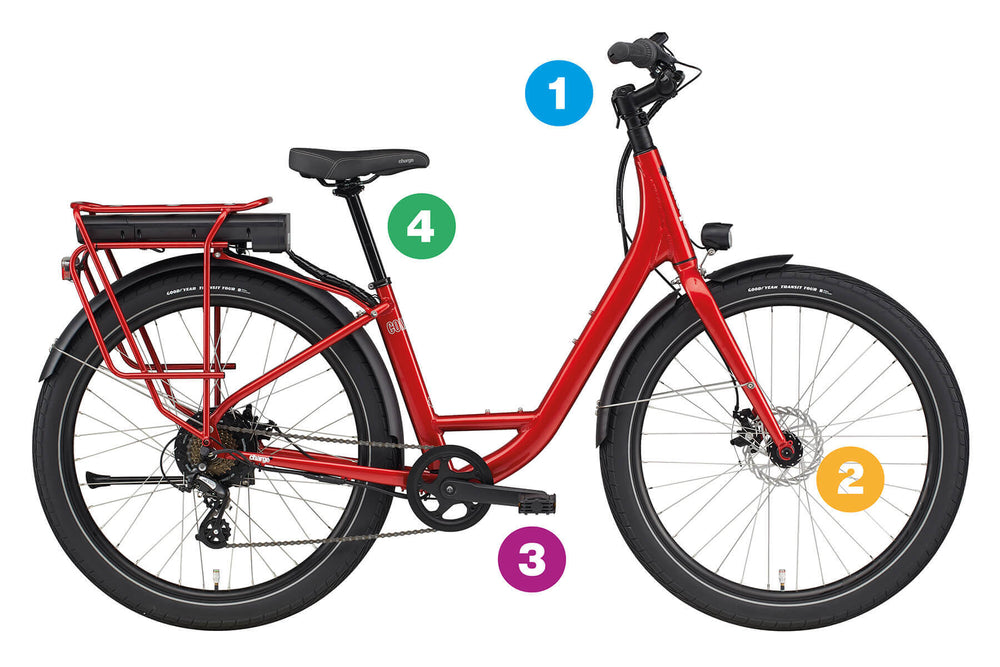
1. Install Handlebars
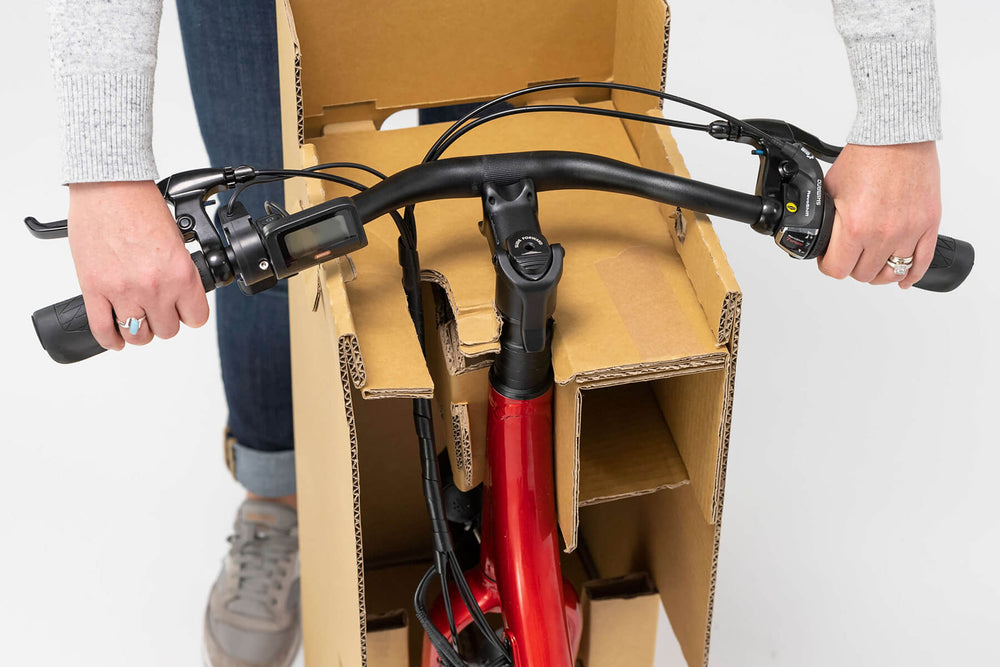
2. Install Front Wheel
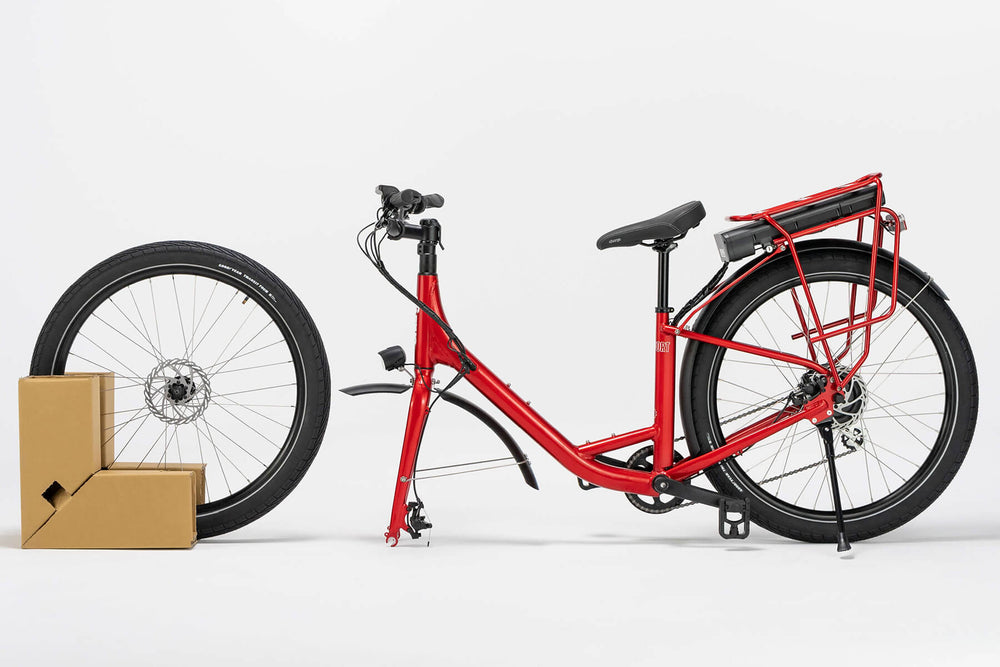
3. Flip Down Pedals
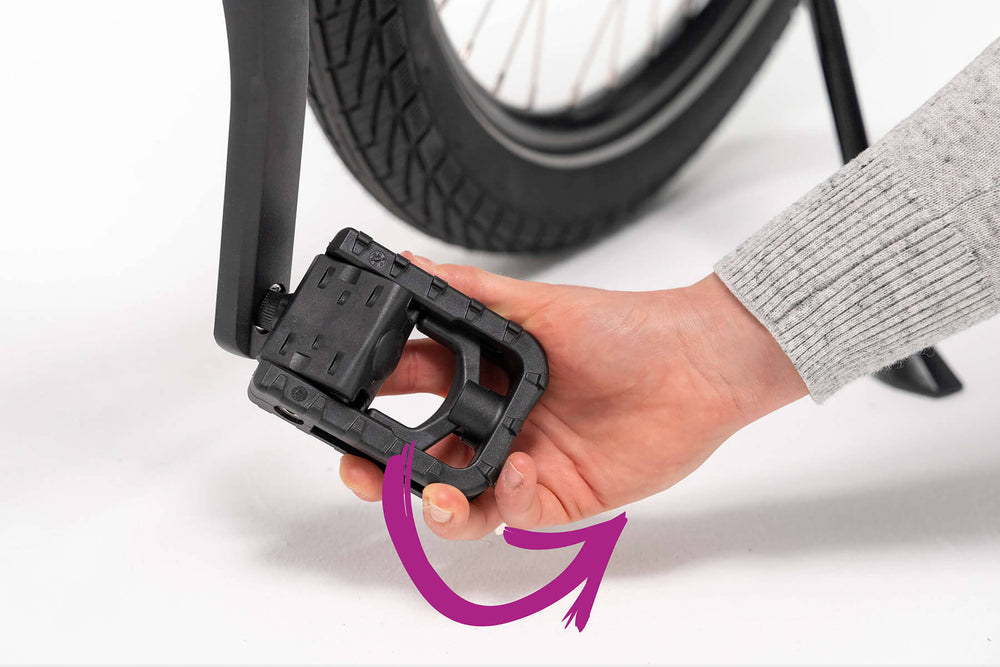
4. Adjust Seat Height
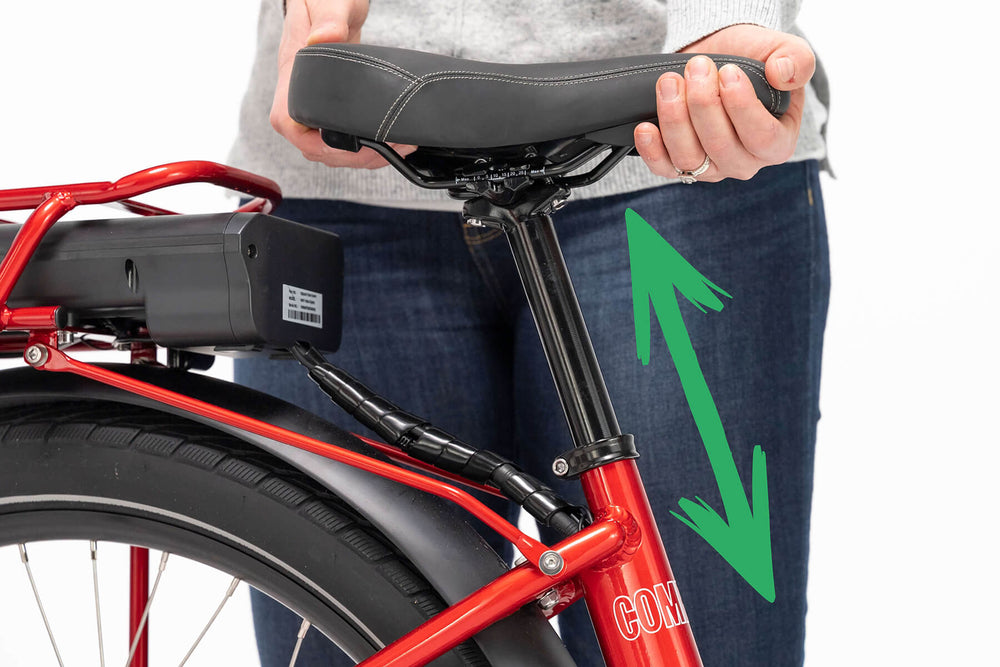
Getting Your Bike Ready for Assembly.
- Parts box
- Stem cover
- Rack block
- Front wheel
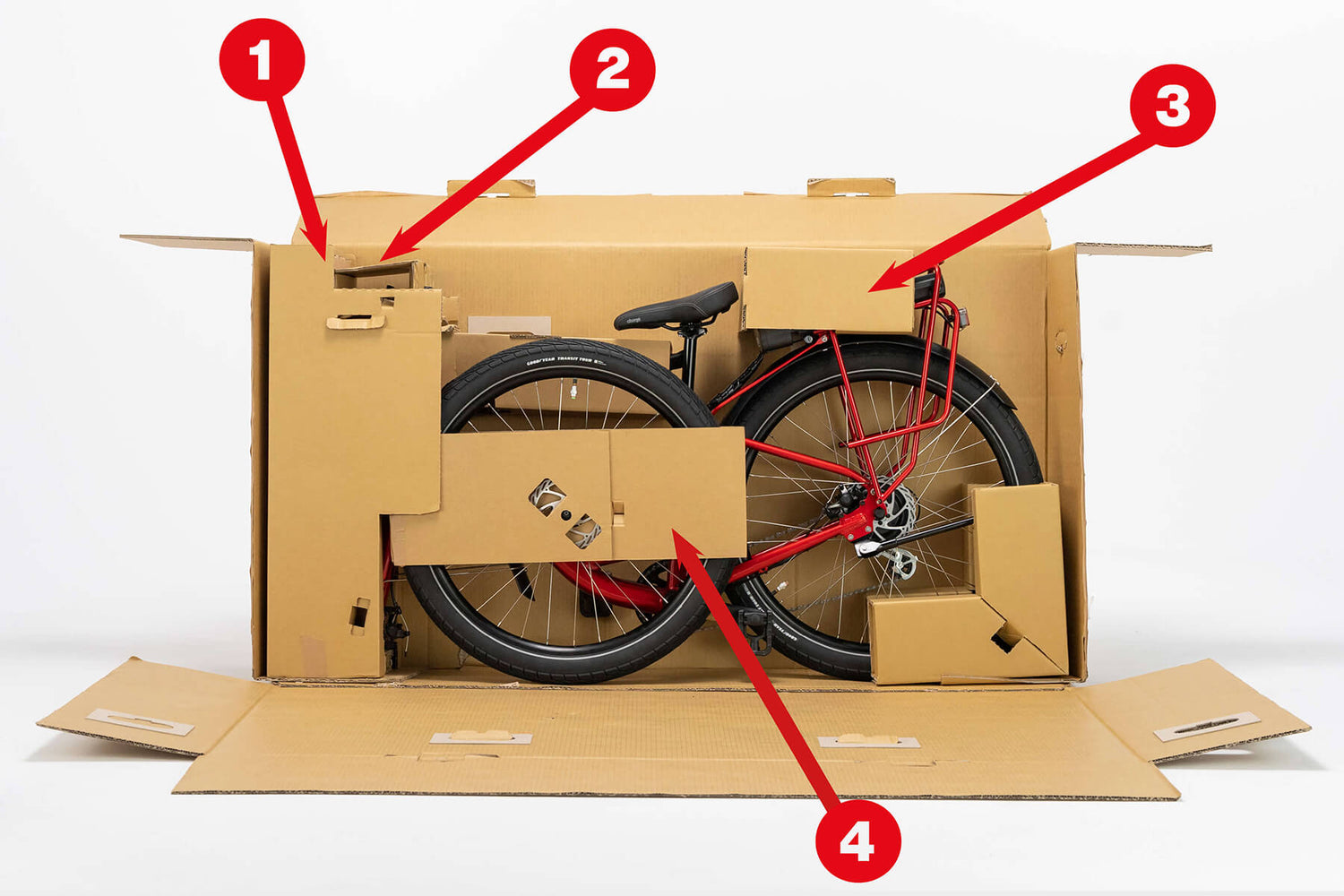
2. Lay the back side of the bike box down to create a clear work space or slide the bike out of the box to an open area where you can complete assembly.
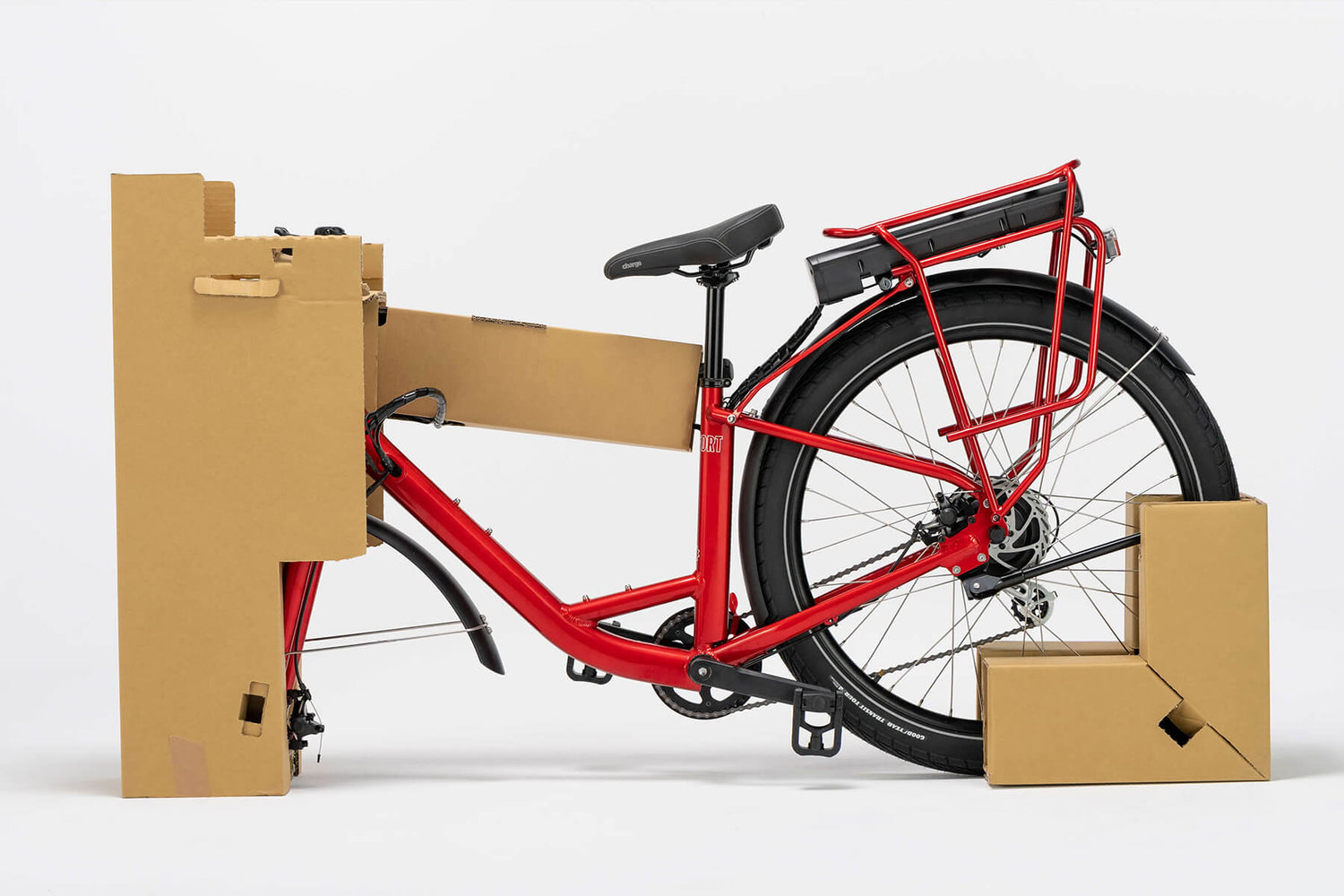
3. Remove the red string around the chain and chainwheel.
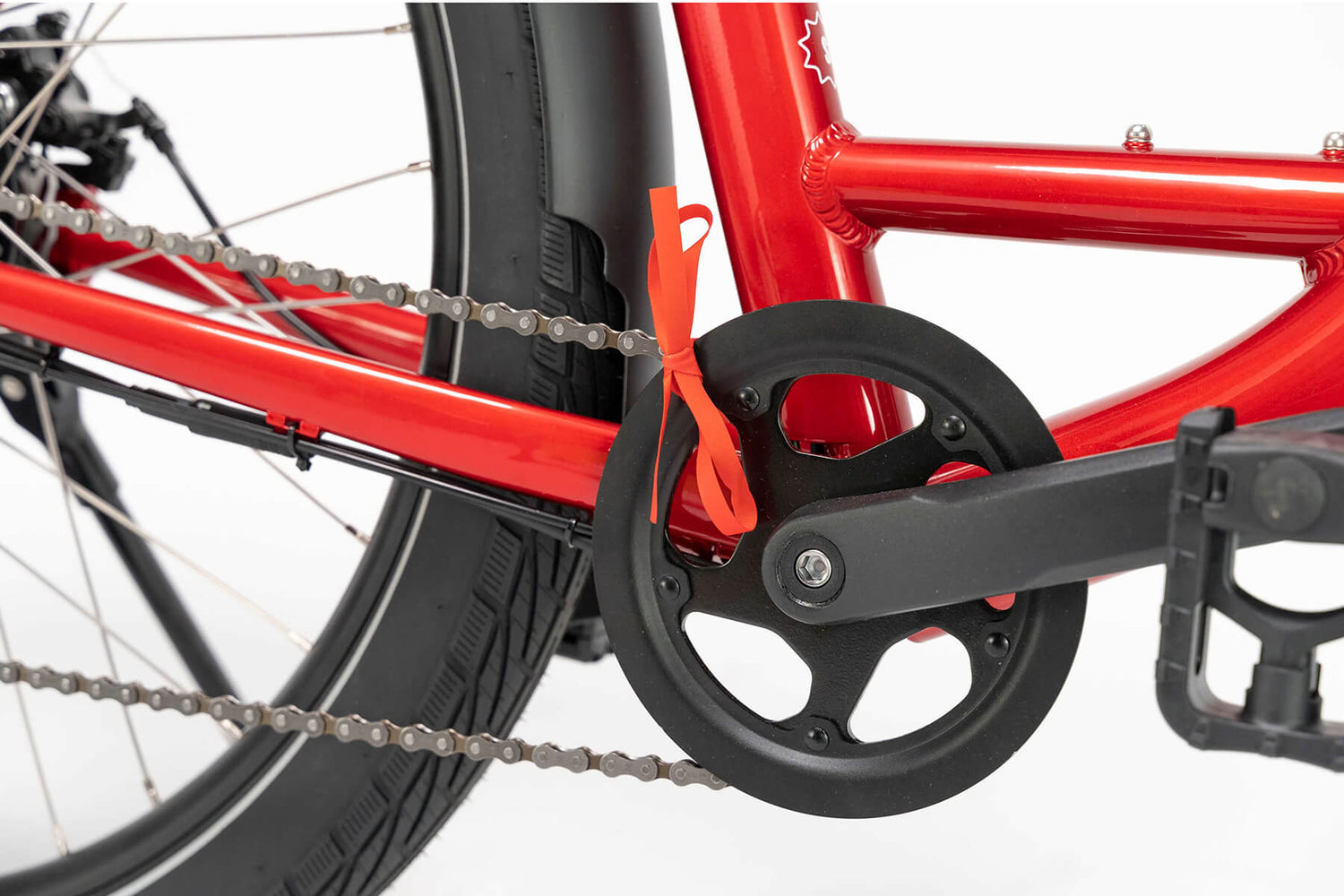
4 Open the parts box.
- Battery Charger
- Axle Rod and Nut
- Tire Pressure Sensors
- Charging Cord
- Battery Keys
- Torque Wrench with 4mm Bit
- 5mm Bit
- Stem Faceplate with four,
4mm Bolts
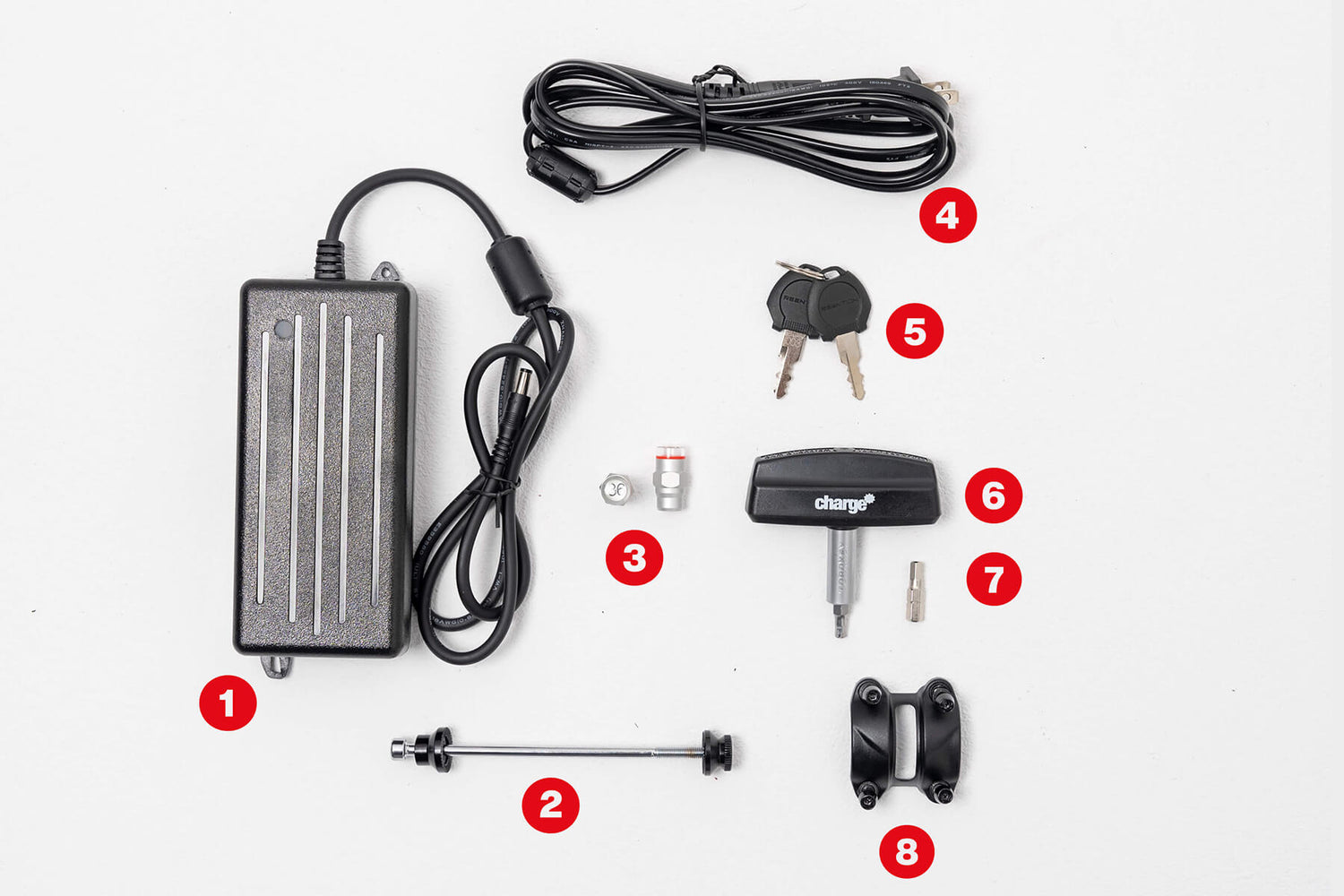
Key Parts of the Bike Referenced in This Guide
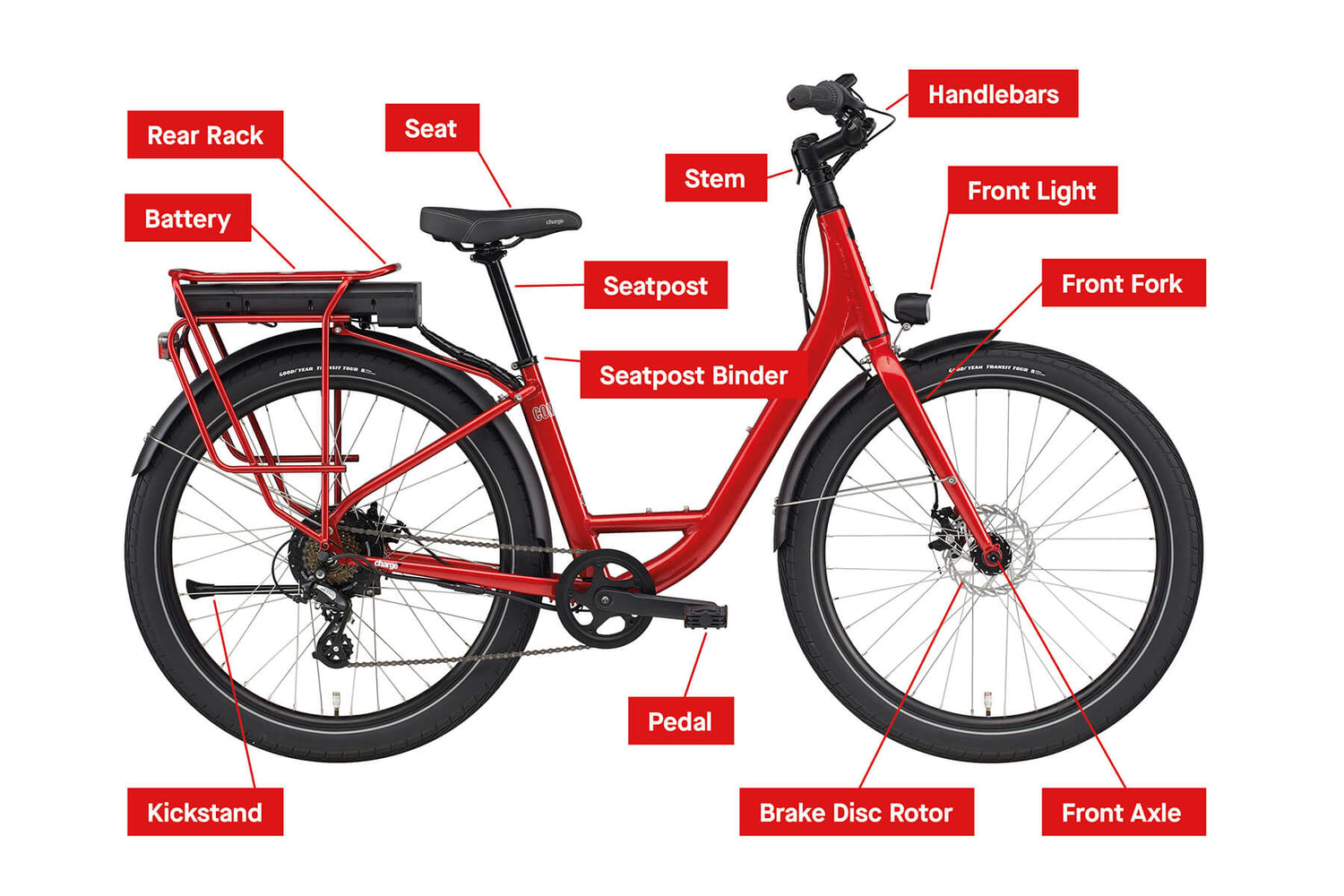
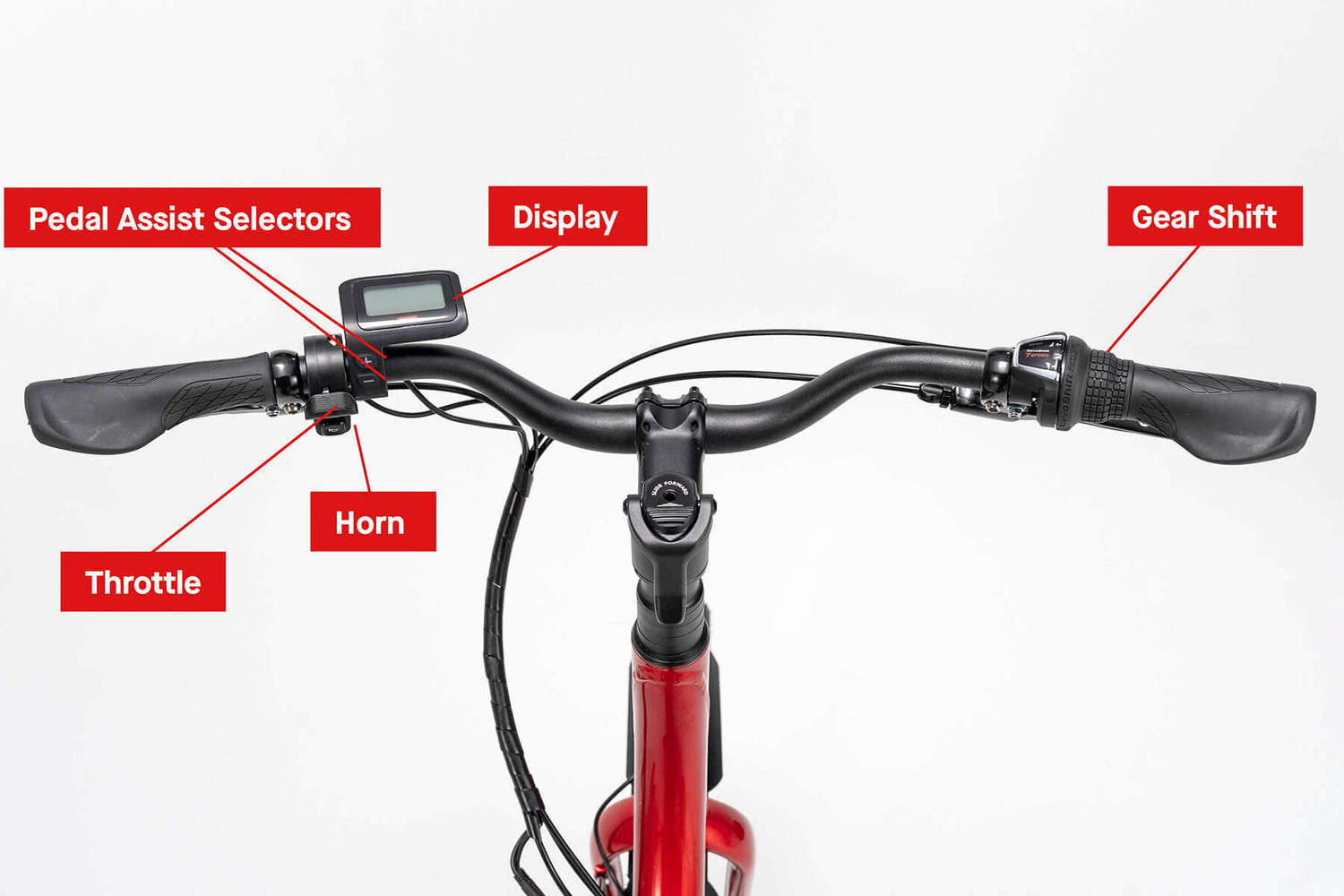
1: Install the Handlebars
This step is particularly important to your safety. Please watch the assembly video above and read "Adjustable Stem Instructions", in your Charge Bicycle Owner’s Manual.
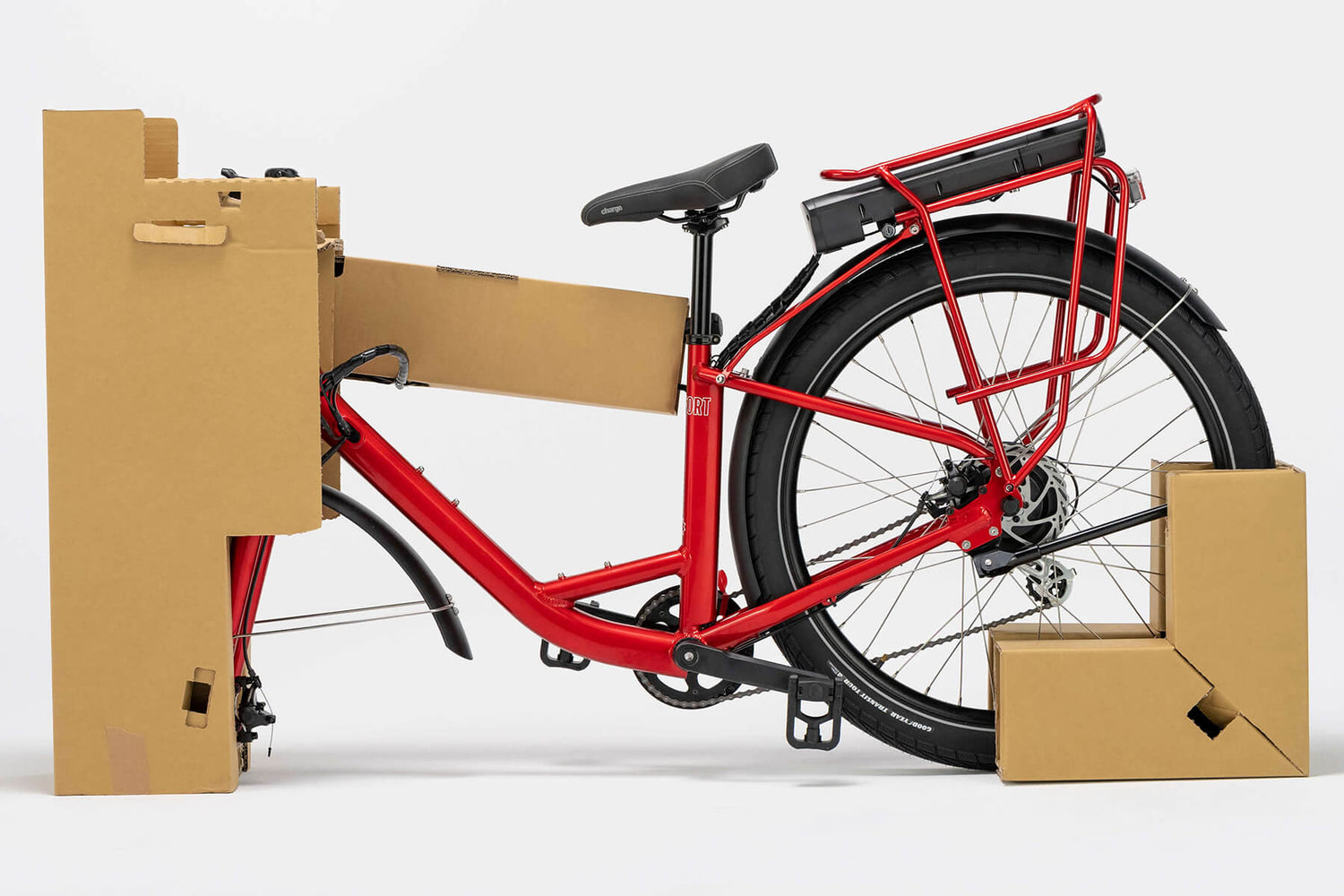
1. The handlebars are located in a cardboard sleeve on the right side of the bike. Slide the handlebars out of the sleeve and place them on the tray made by the top of the cardboard shroud. Make sure the wires and cables running from the handlebars to the bike frame aren’t twisted.
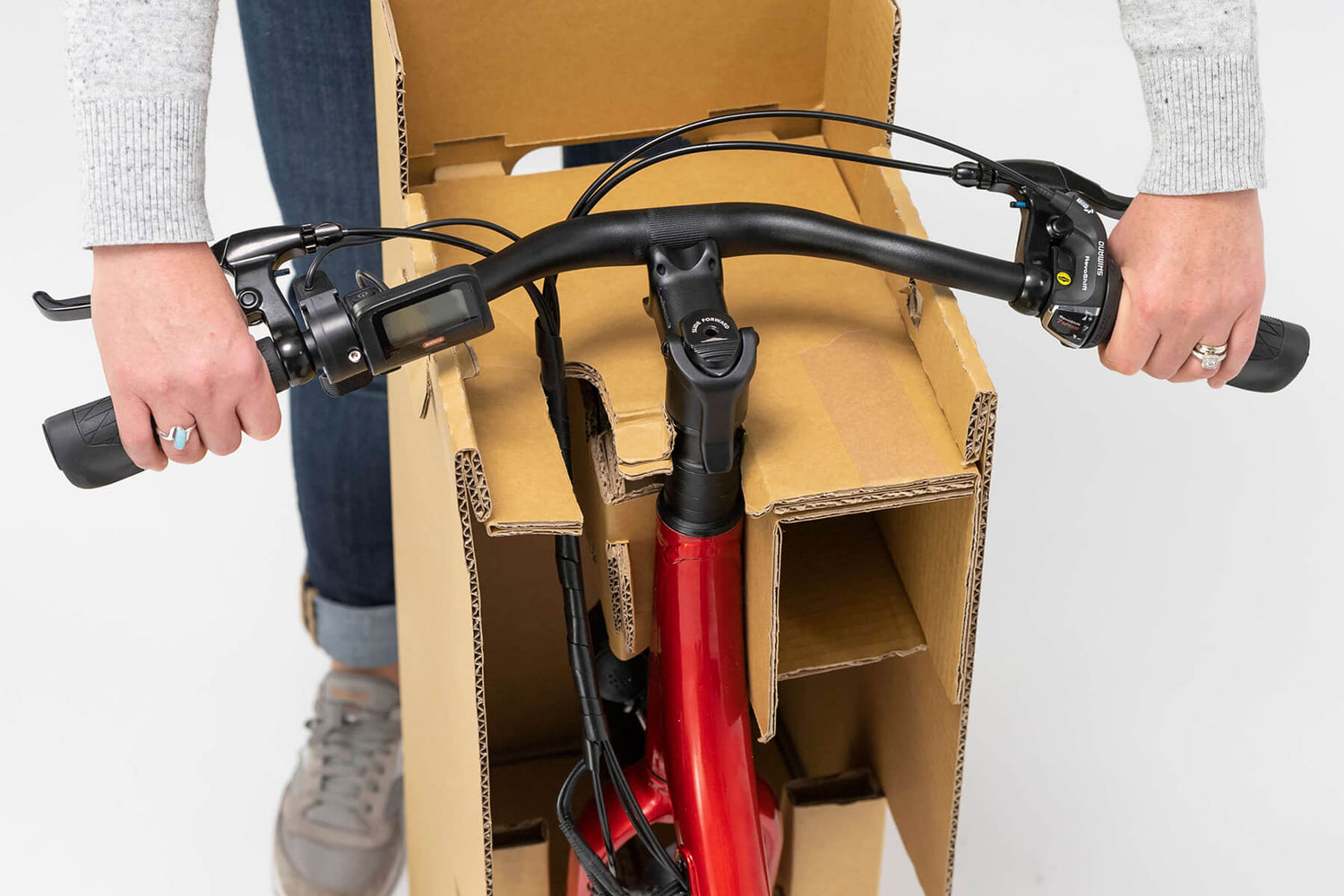
2. Ensure the power is OFF before continuing assembly by confirming the handlebar display is blank.
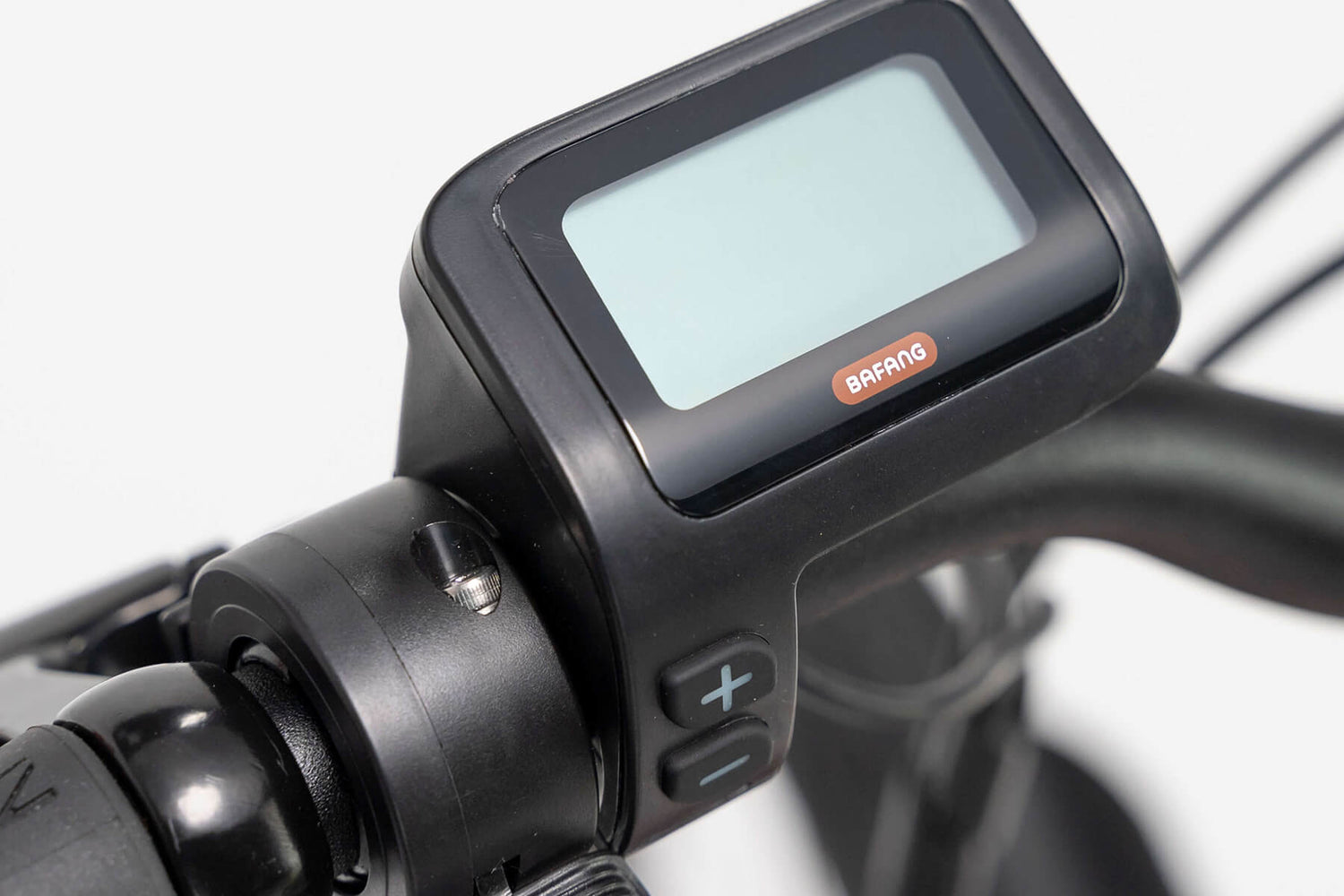
If power is on, press and hold the power button until the display shuts off.
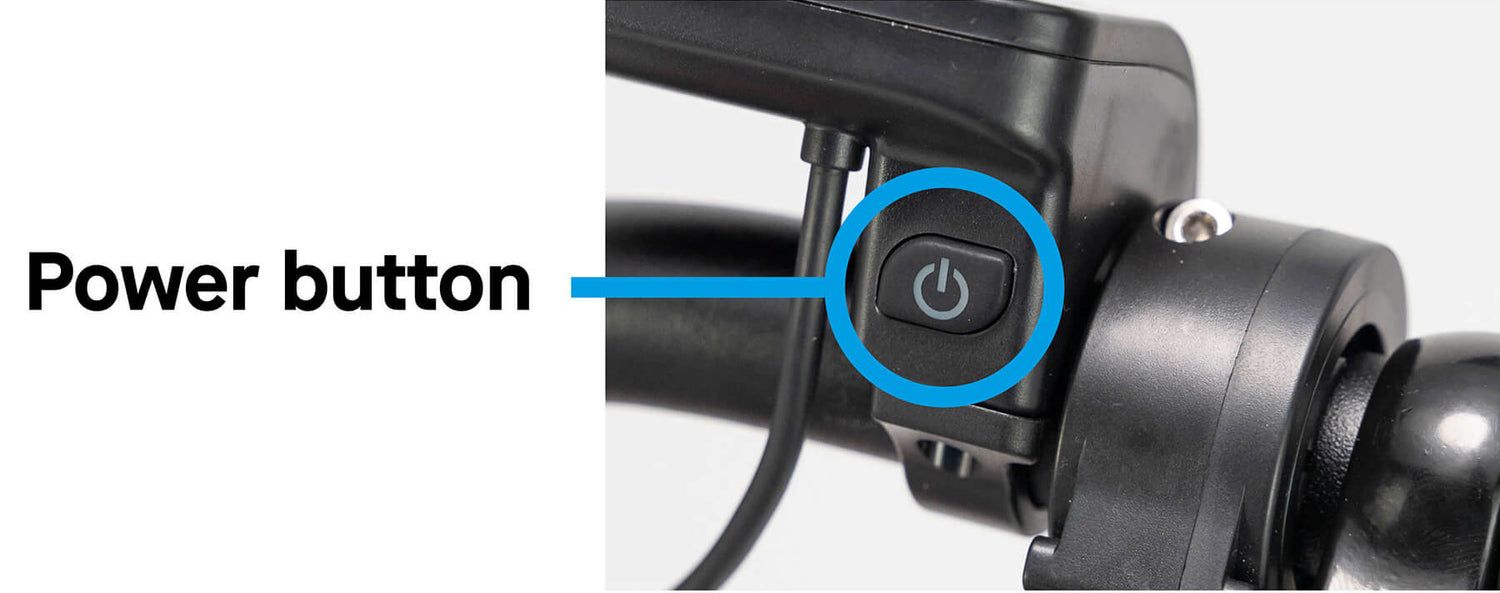
3. Find the stem faceplate and the four, 4mm stem bolts located in the parts box.
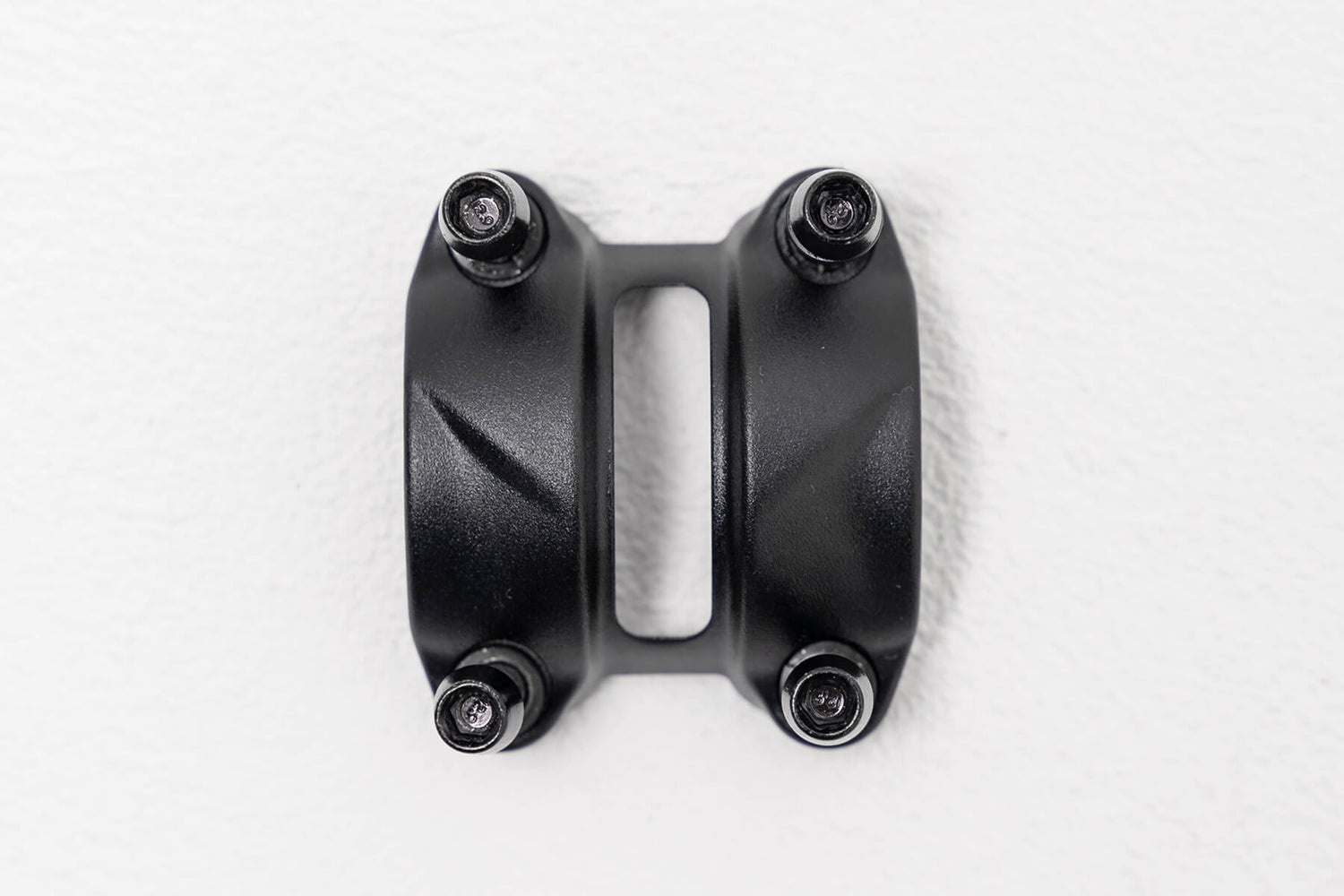
4. Slide the handlebars so they are tight against the bike stem.
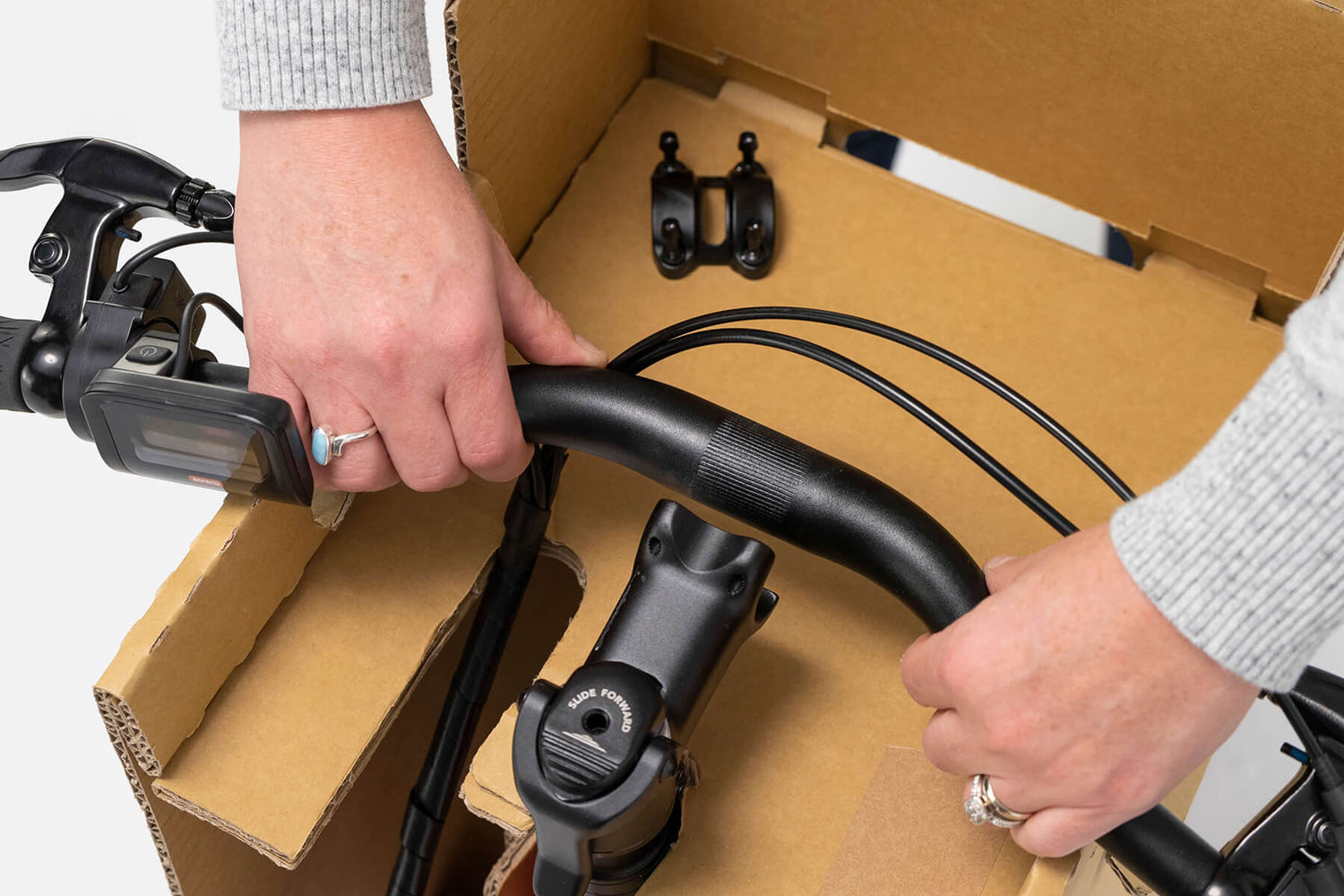
5. While holding the bars against the stem, place the faceplate on the opposite side of the handlebars and loosely thread the four, 4mm bolts into the four holes on the stem (two above the handlebars and two below).
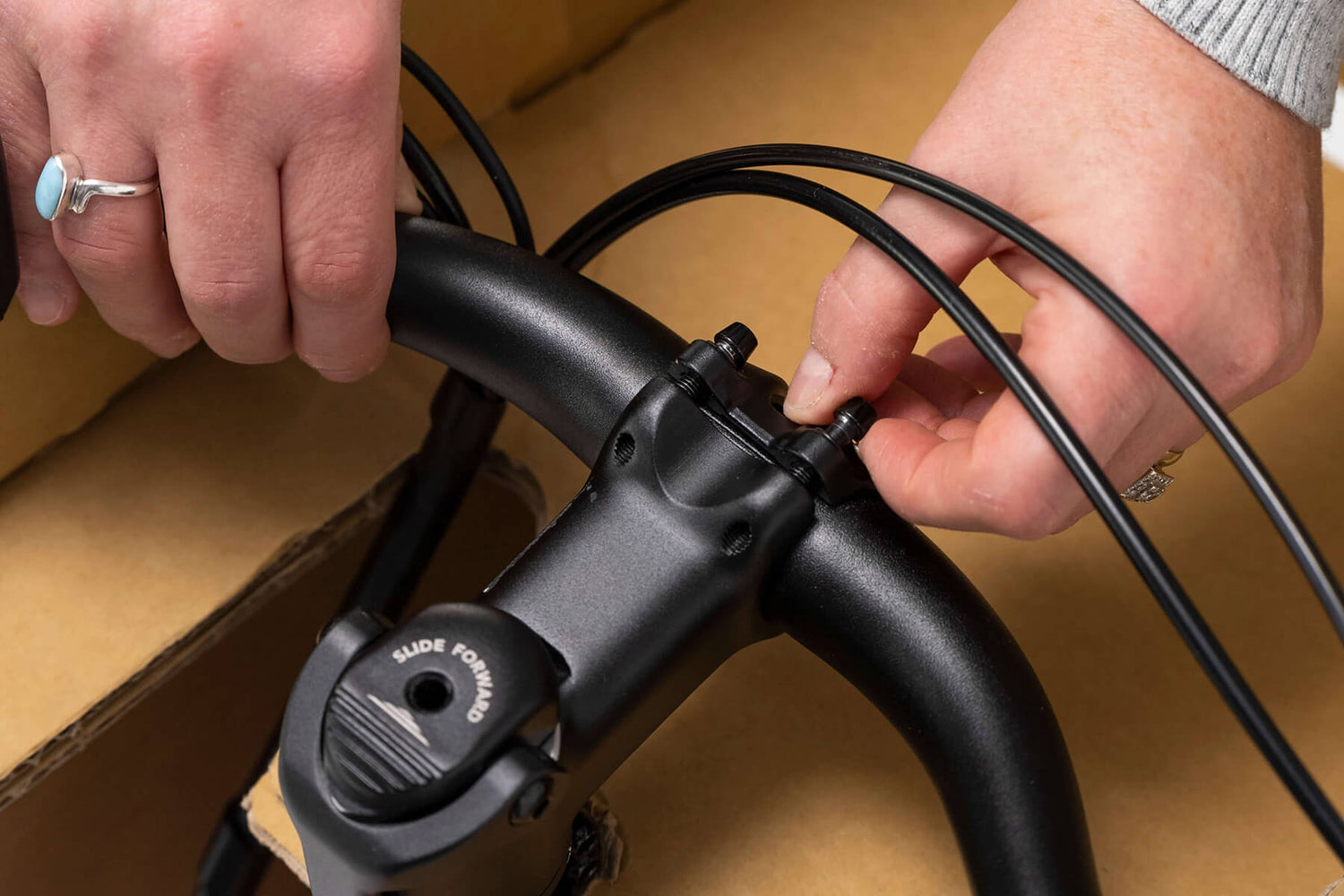
6. Move to the back of the bike and slide the cardboard wheel block off the rear wheel, then put the kickstand down.
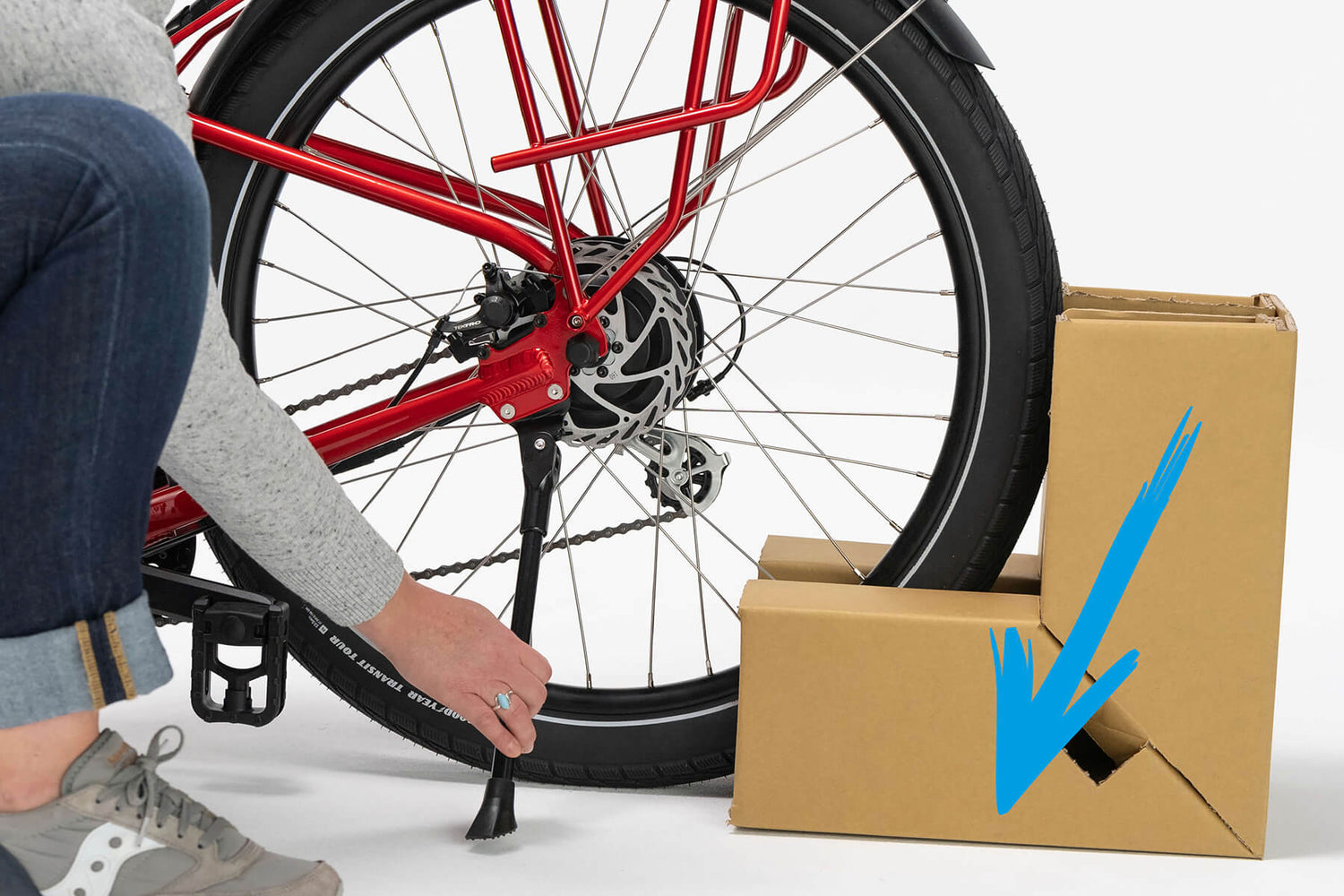
7. Move to the front of the bike and remove the cardboard shroud from around the front of the bike. The kickstand will keep the bike from falling over.
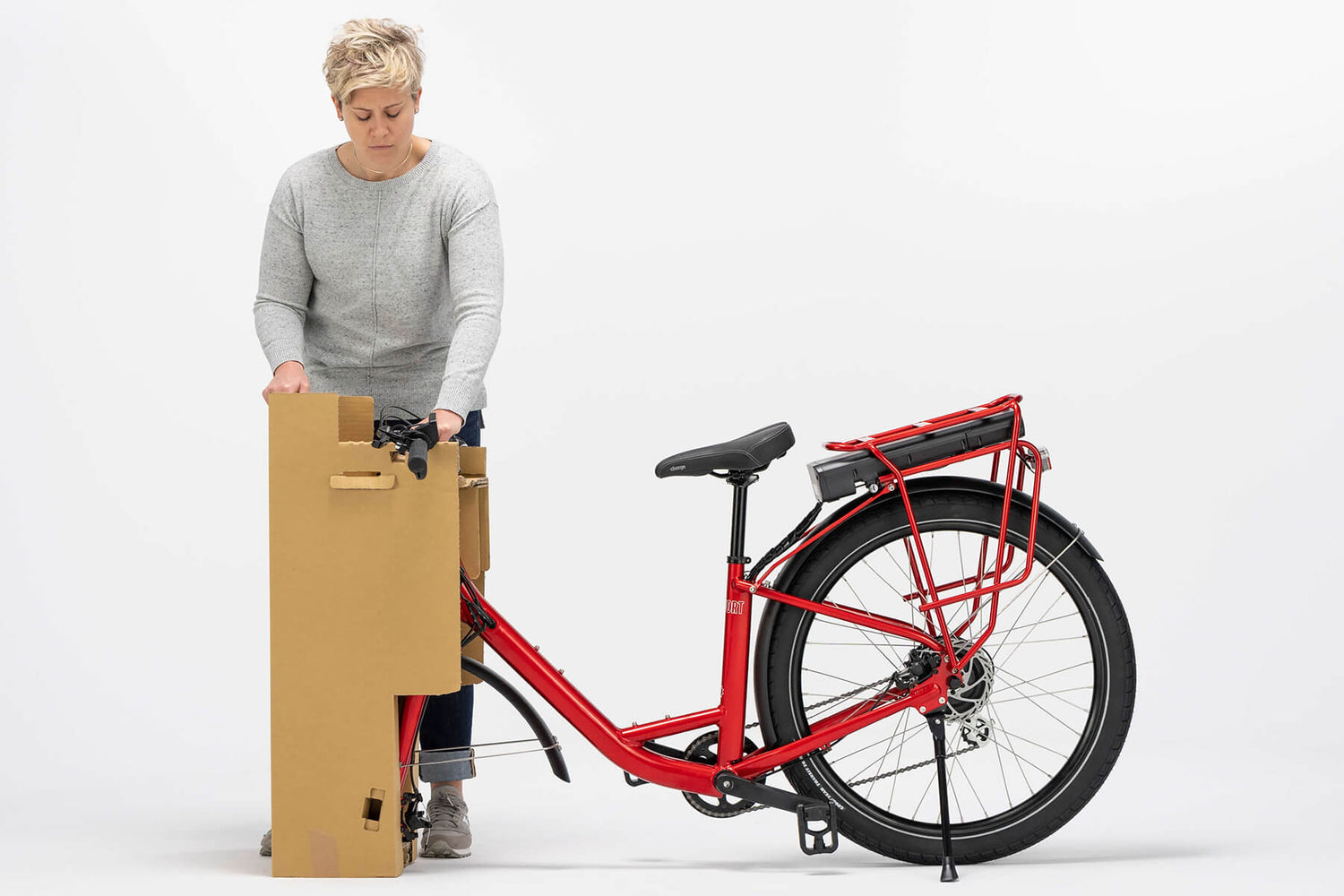
8. Grab the torque wrench from the parts box.
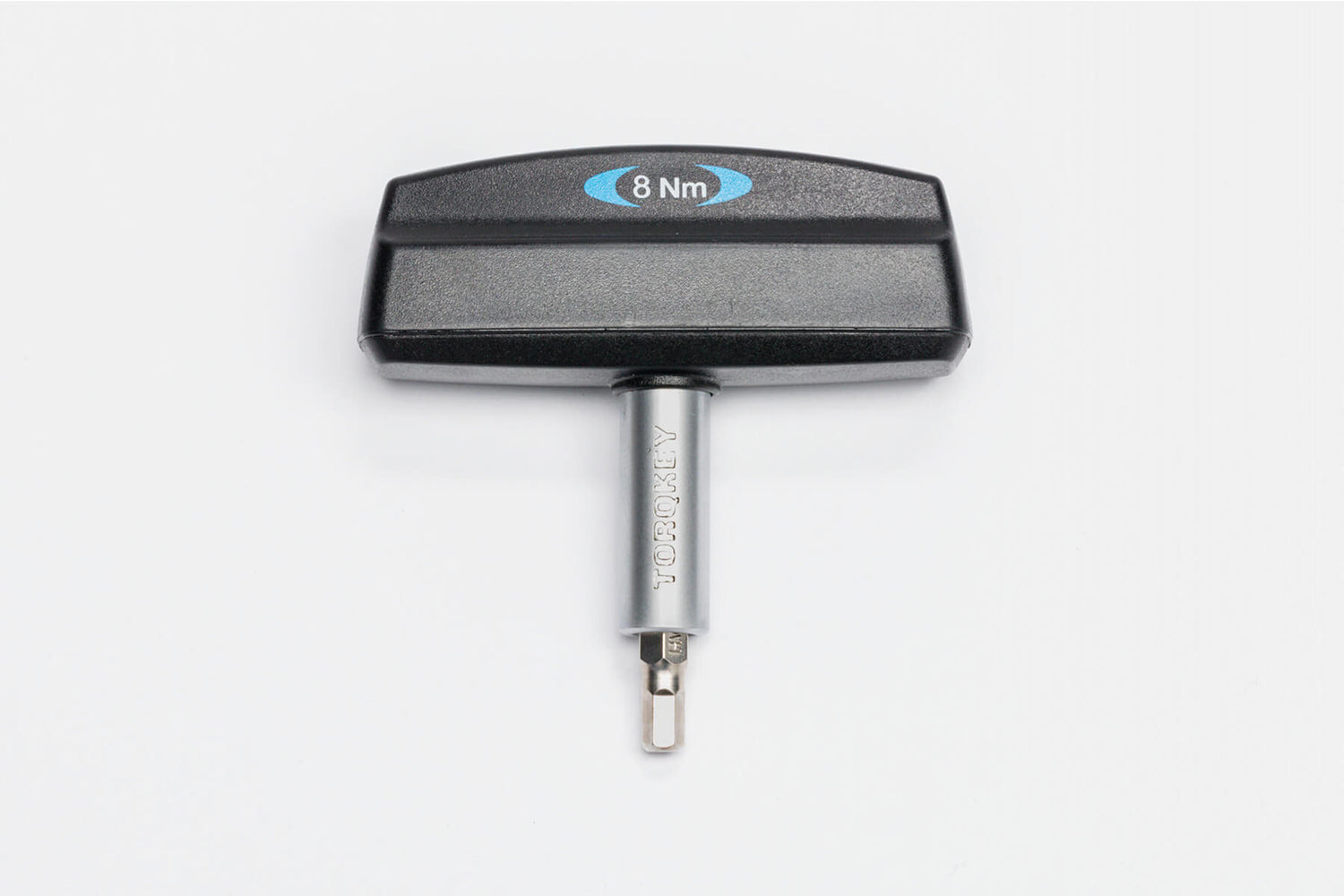
9. Use the positioning guide sticker to center the handlebars. When looking at the bike from the front, the sticker should be just to the left of the stem and the “Center” mark should be in-line with the gap between the stem and faceplate. No part of the sticker should be under the stem.
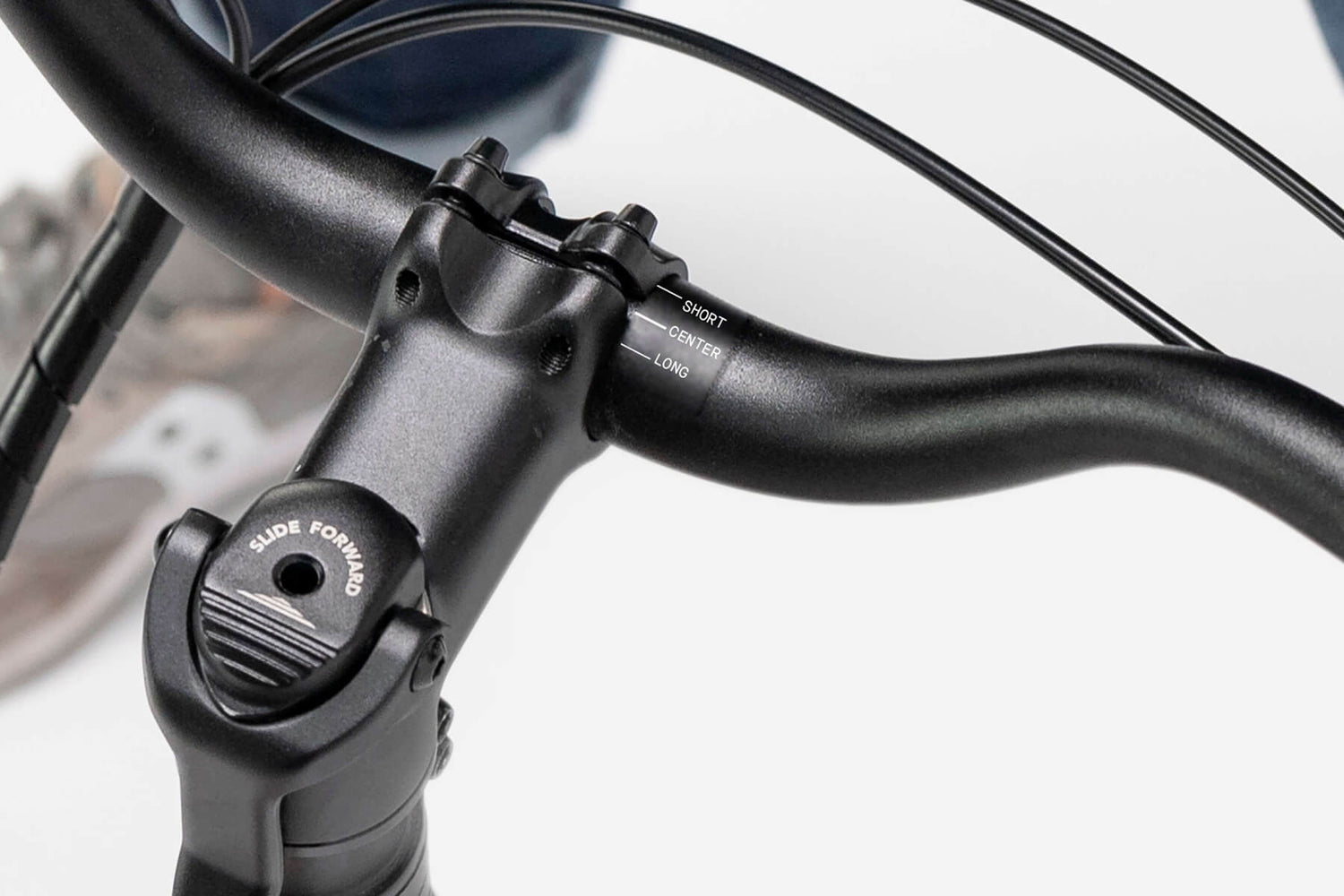
10. If you prefer the handlebars to be a bit closer or a bit farther away, you can rotate them forward or backward to the desired position, using the face of the stem and the positioning guide sticker as reference.
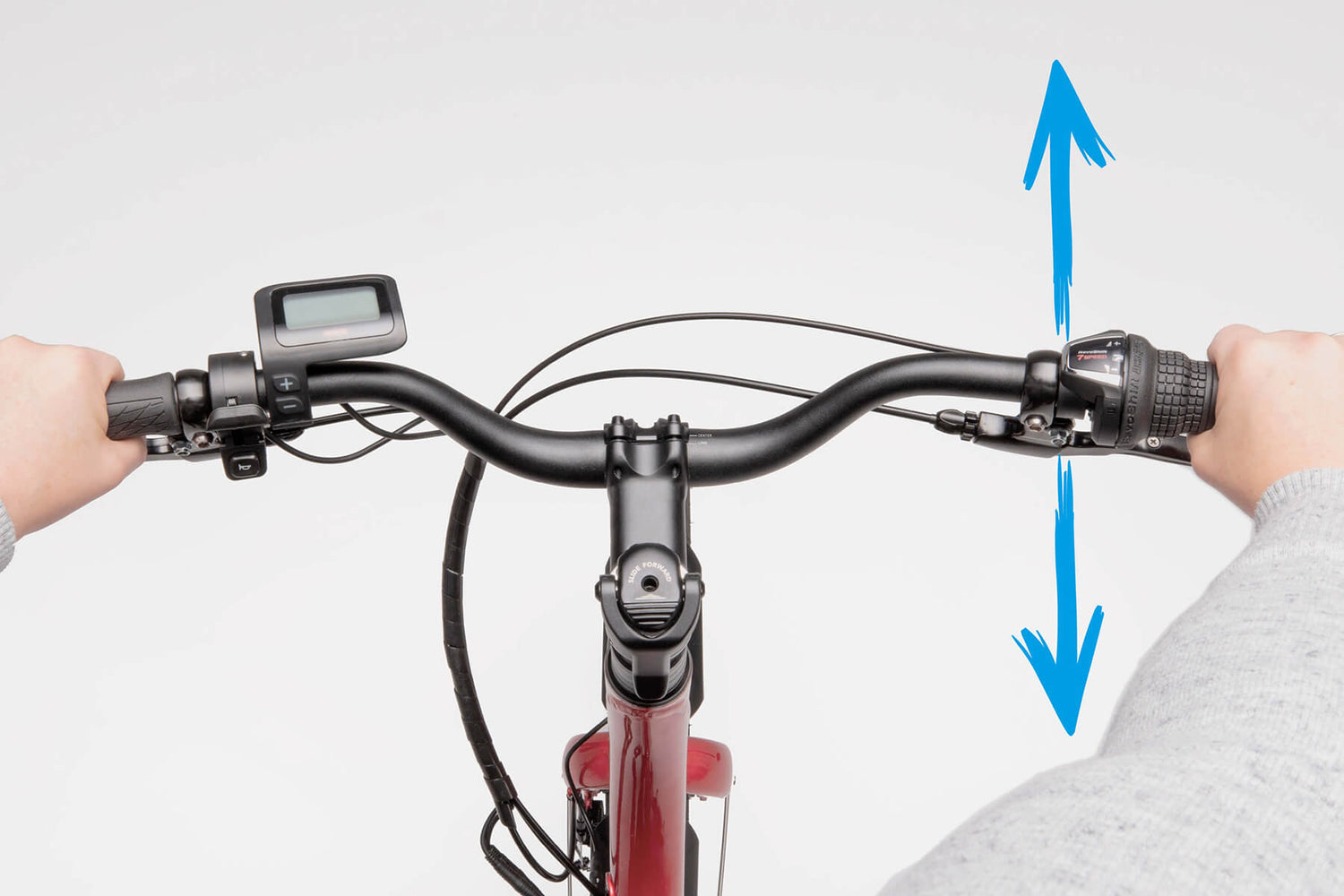
11. Once the handlebars are in the desired position, turn the two top faceplate bolts clockwise, tightening them just until the rubber O-ring makes contact with both the stem and stem faceplate.

12. Ensure all faceplate bolts have reached required torque by using the torque wrench to turn the bolts clockwise, tightening them until you hear and feel the torque wrench click, following the pattern in Diagram A.
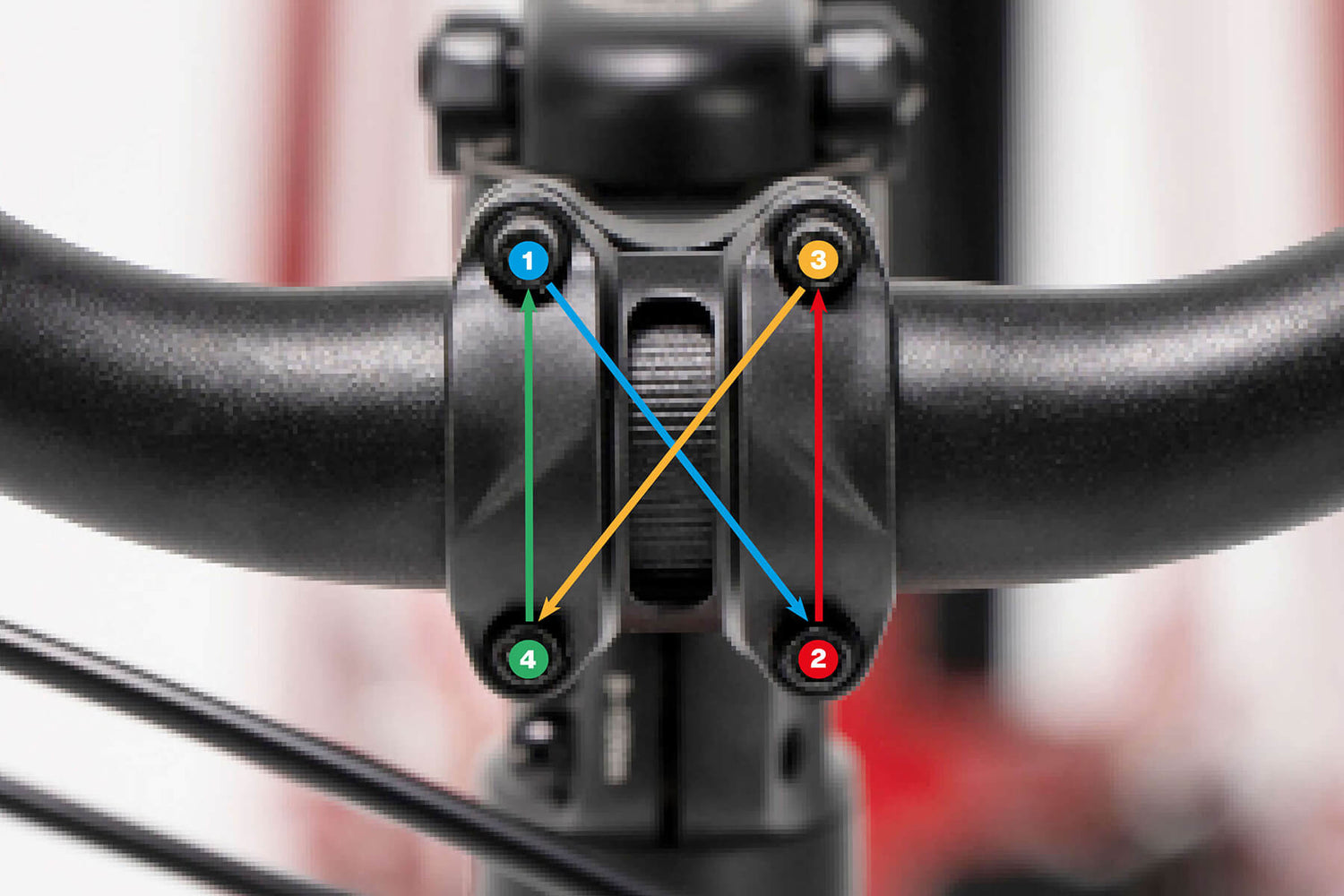
2: Install the Front Wheel
This step is particularly important to your safety. Please see the assembly video above as well as this Quick Start Guide.
1. Use the cardboard block that says, “Save this block” and lay it flat on the ground with the side that says, “This side down” flat on the floor.
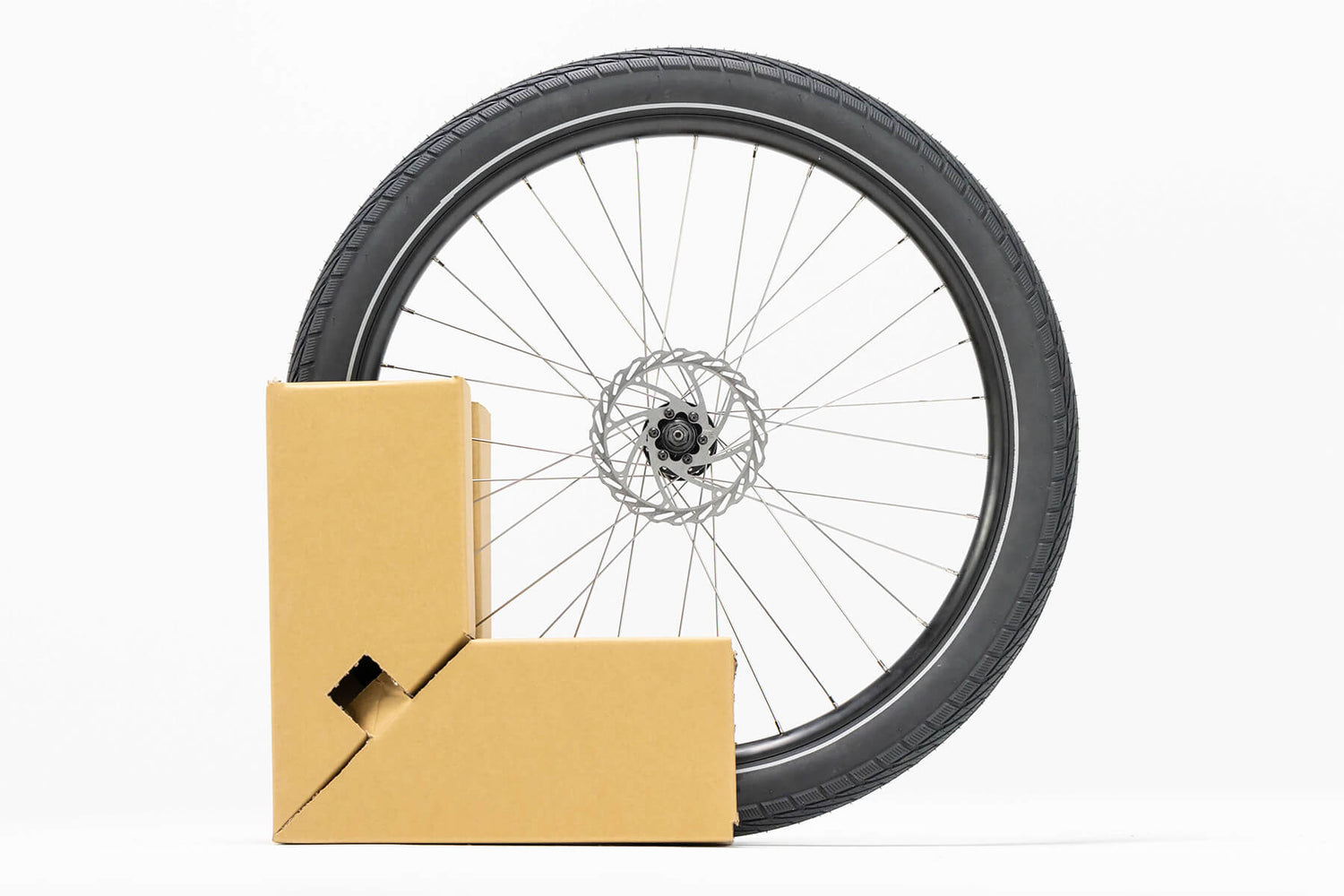
2. Insert the front wheel into the block. Verify the disc brake rotoris on the side marked “Brake Disc This Side”.
NOTE: The front wheel should now stay upright on its own in the temporary stand.
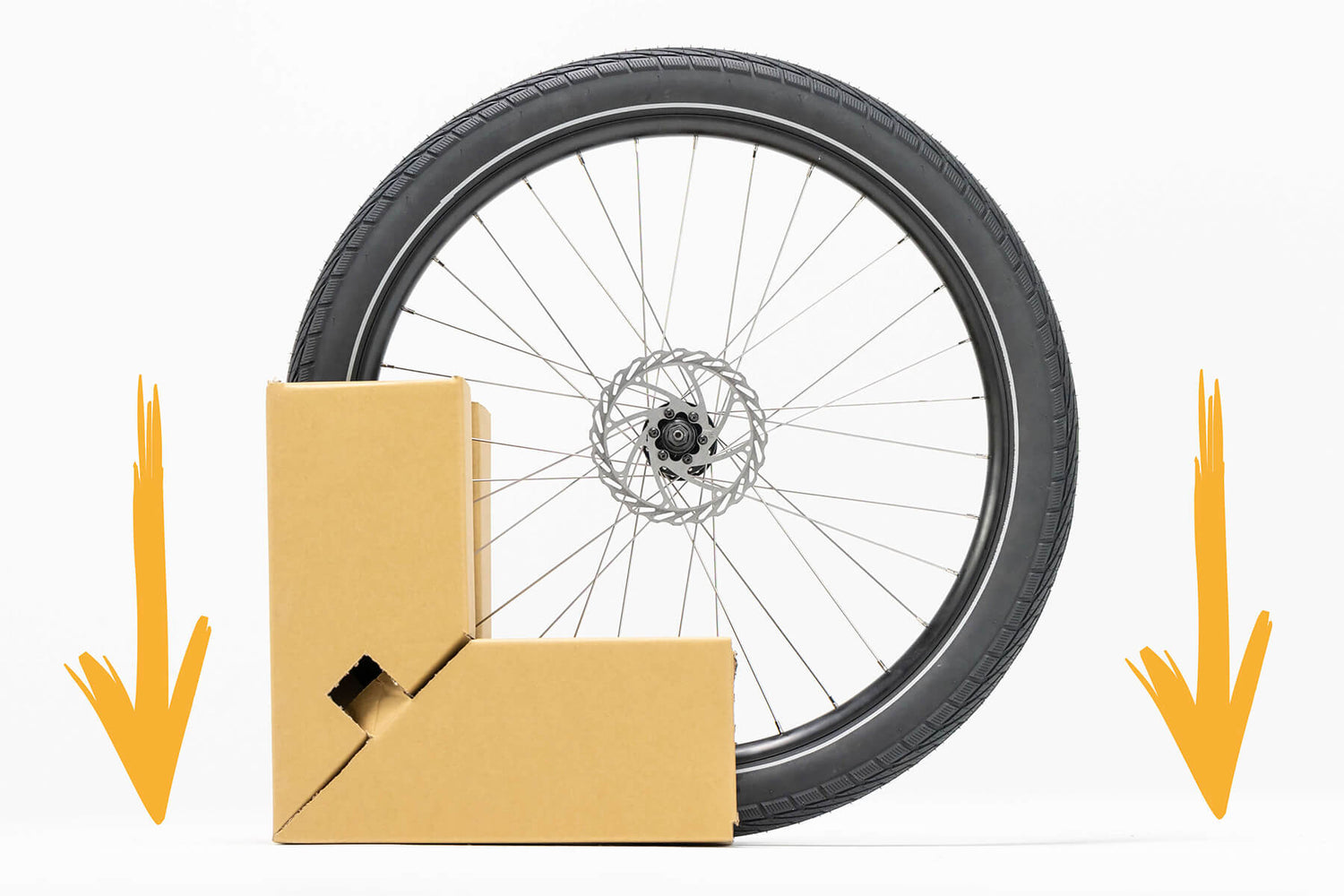
3. Place the front wheel and the wheel stand in front of the bike. Verify the front wheel disc brake rotor is on the same side as the kickstand.
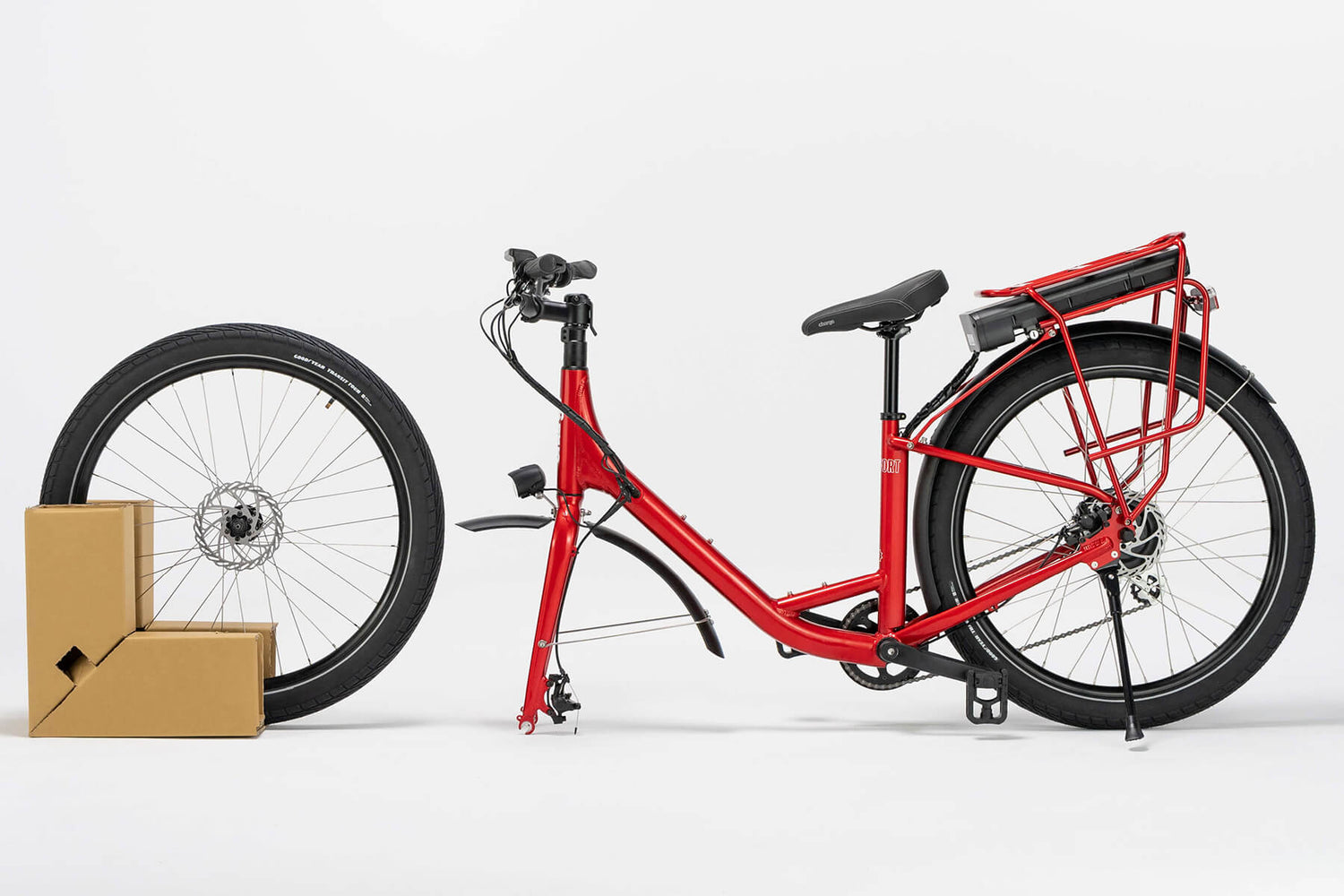
4. Locate the front fork spacer and place your foot on top.
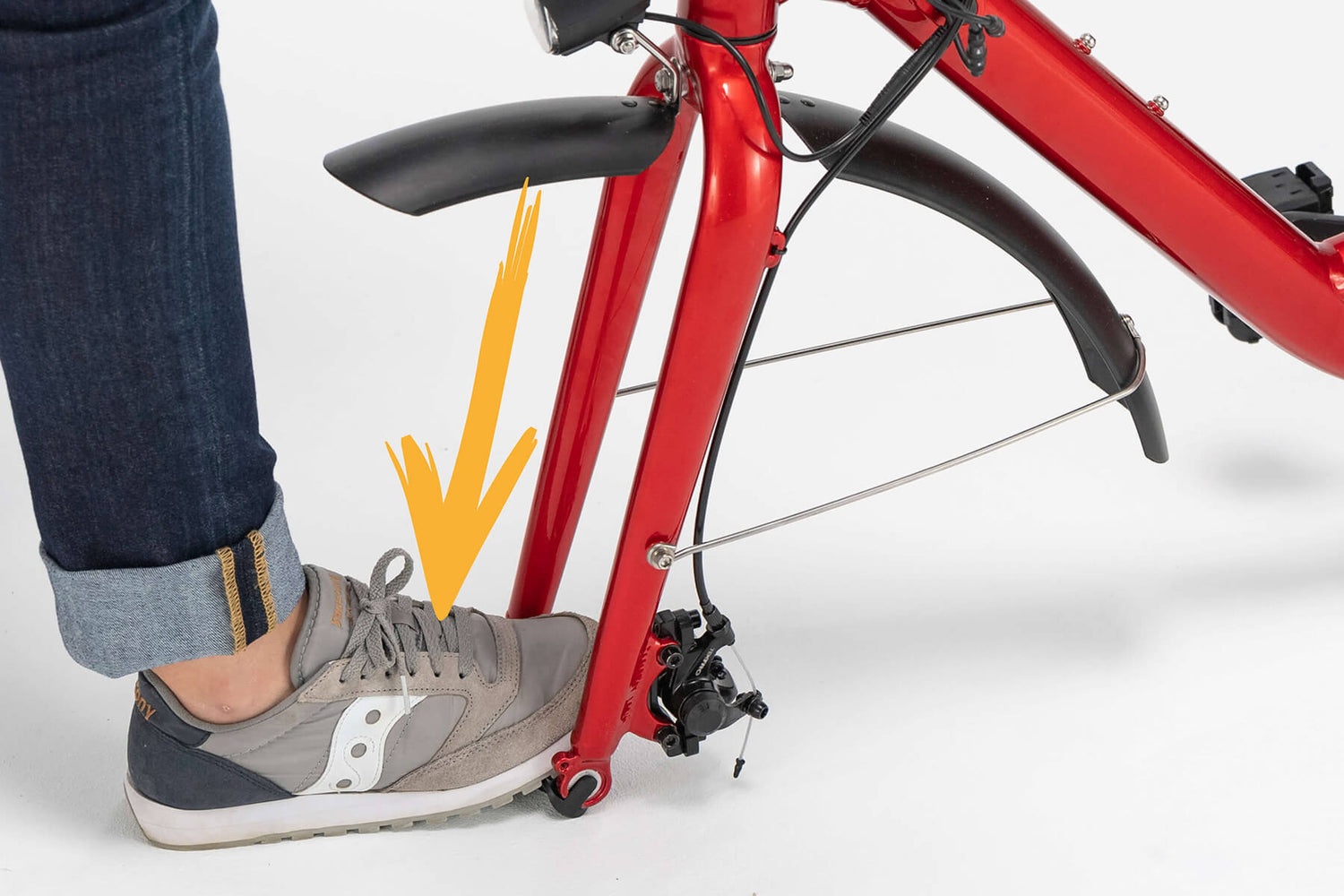
5. Holding the handlebars, lift the bike up to remove the spacer.
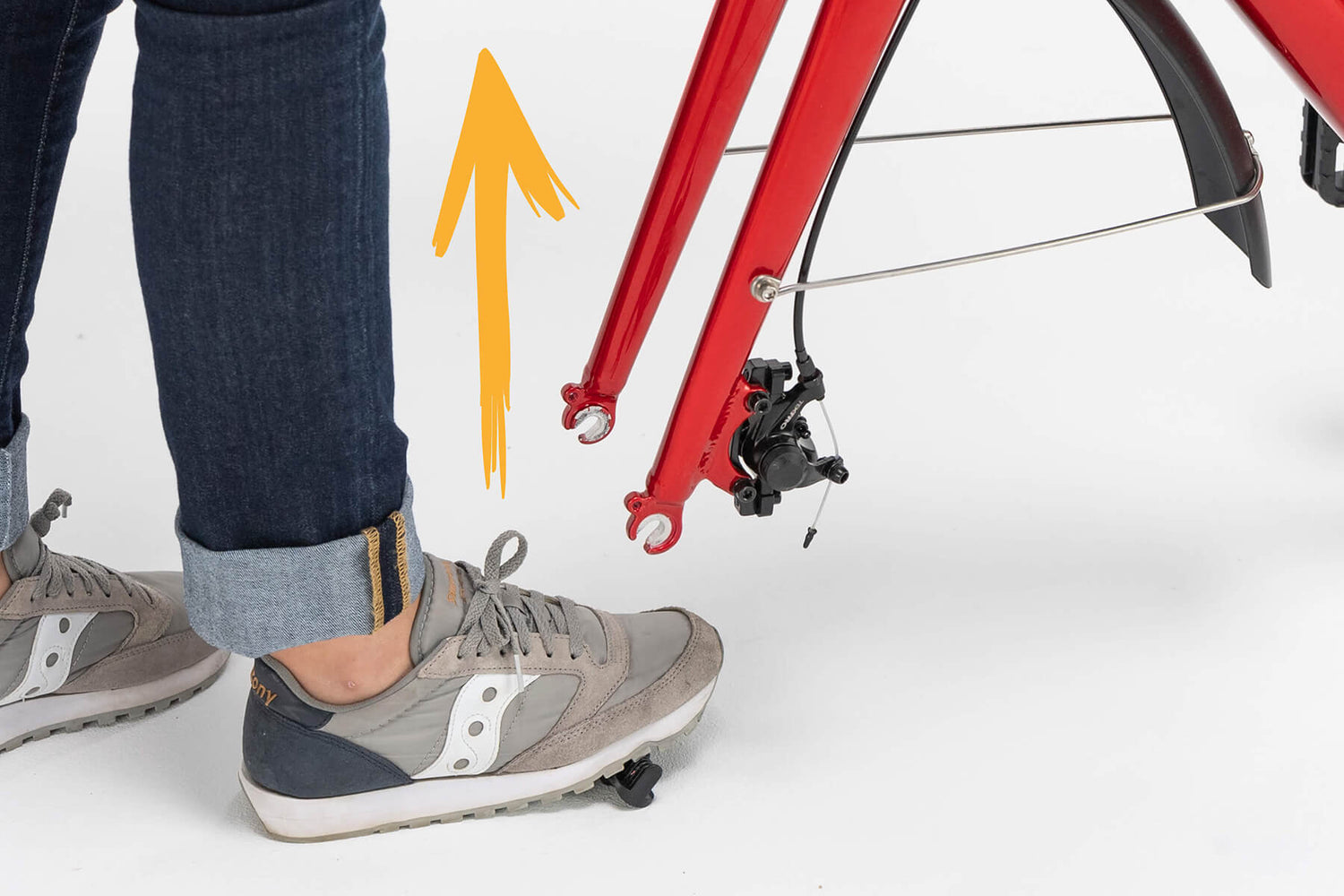
6. Lift the bike over to the front wheel.
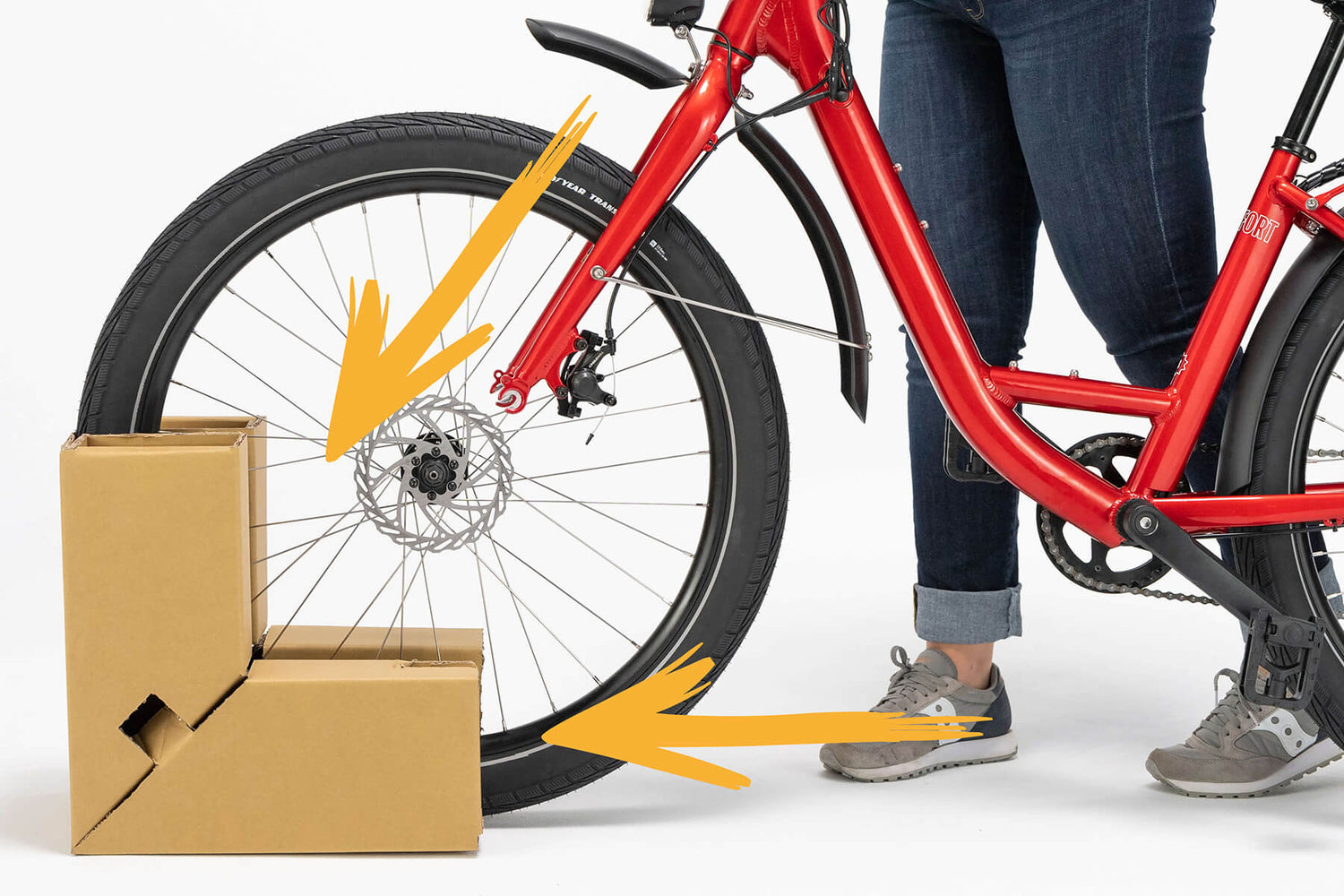
7. Lower the fork onto the front wheel until the axle is fully-engaged in the fork end.
NOTE: While the wheel axle does not extend past the fork end, it is enough for the fork to rest securely, as pictured.
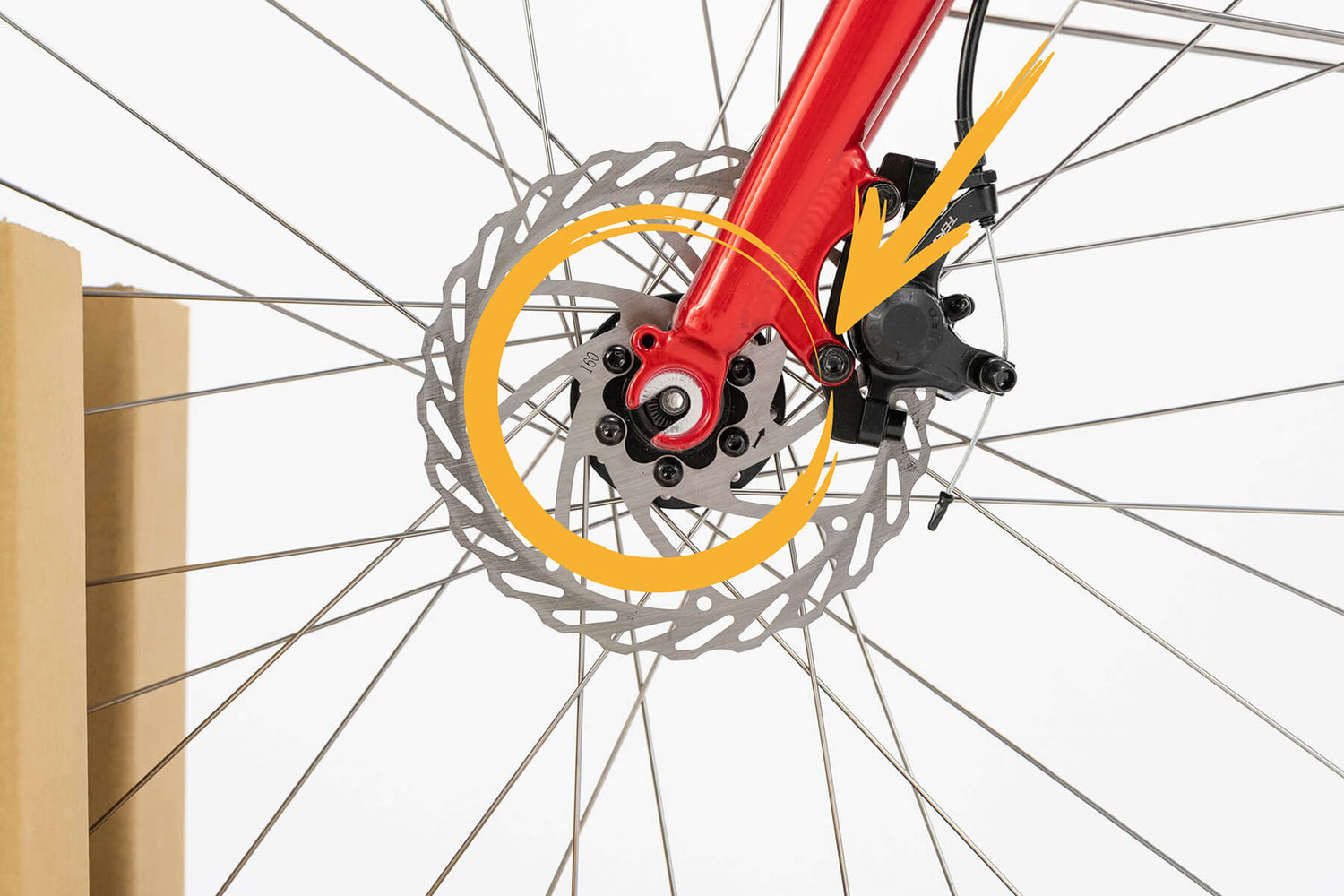
8. Locate the metal axle rod and axle nut from the parts box.
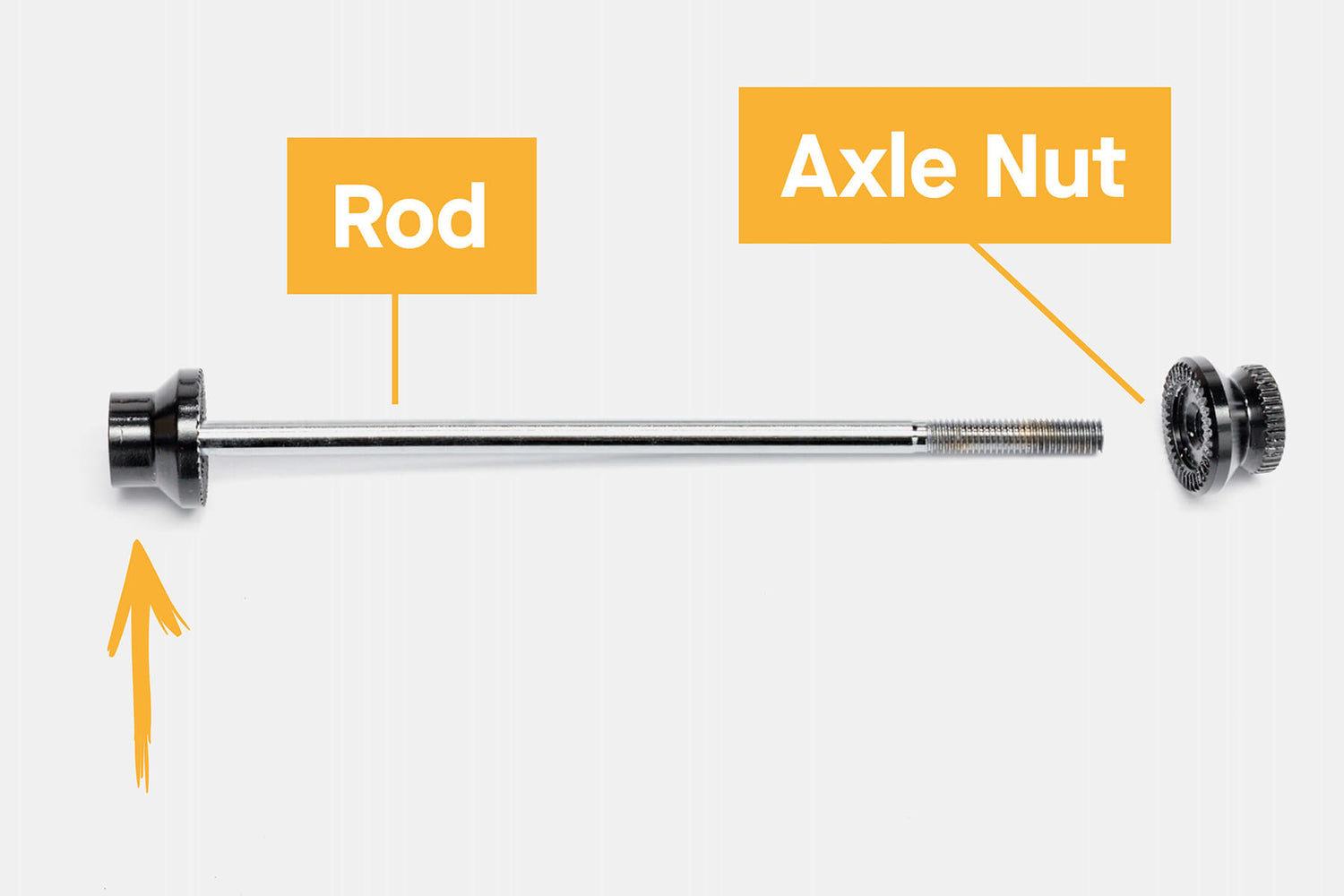
9. While facing the front of the bike (looking at the headlight), use your right hand to insert the metal rod through the axle from brake disc side.
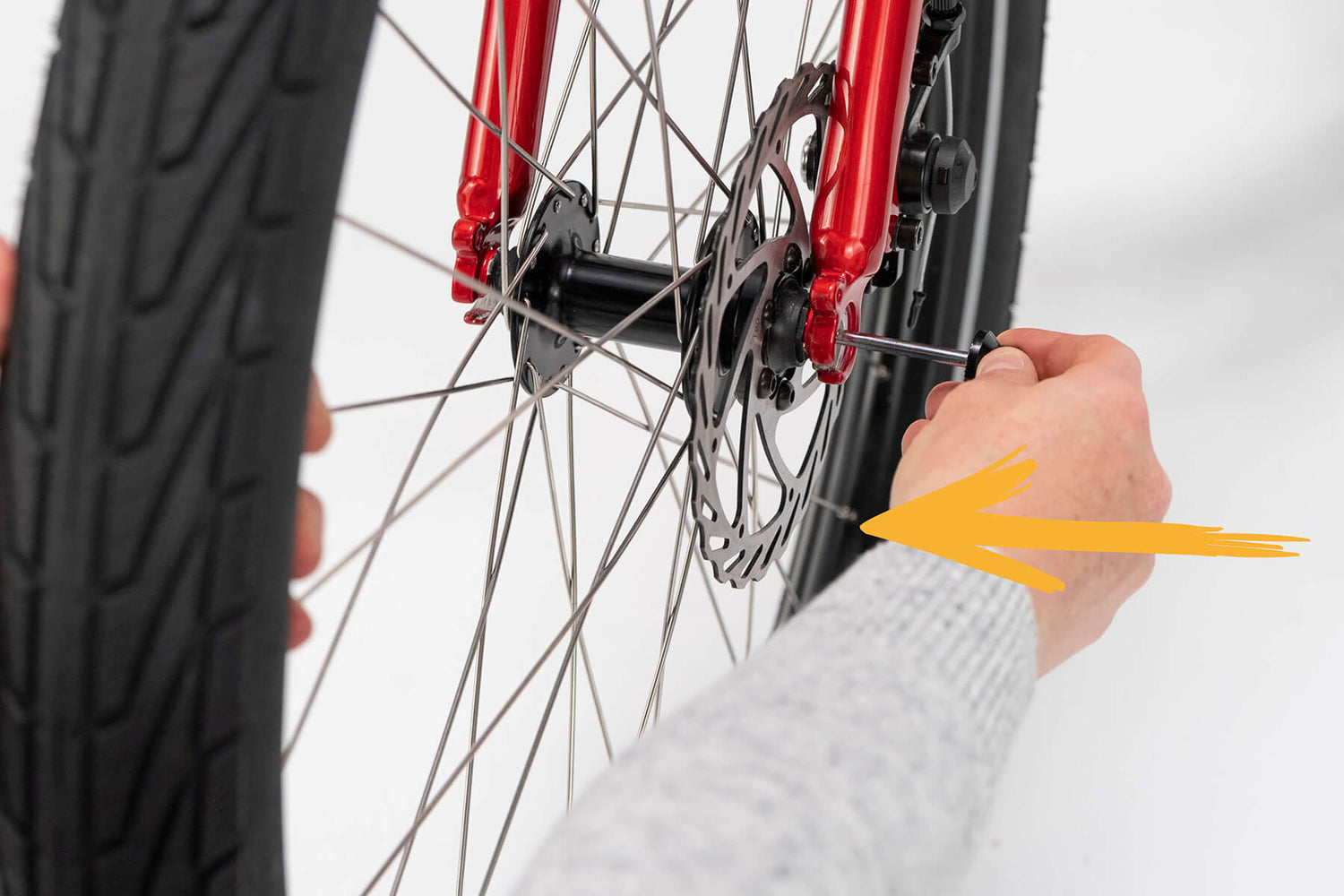
10. With your left hand, screw the axle nut onto the axle rod, making sure the large end of the nut goes onto the rod first.
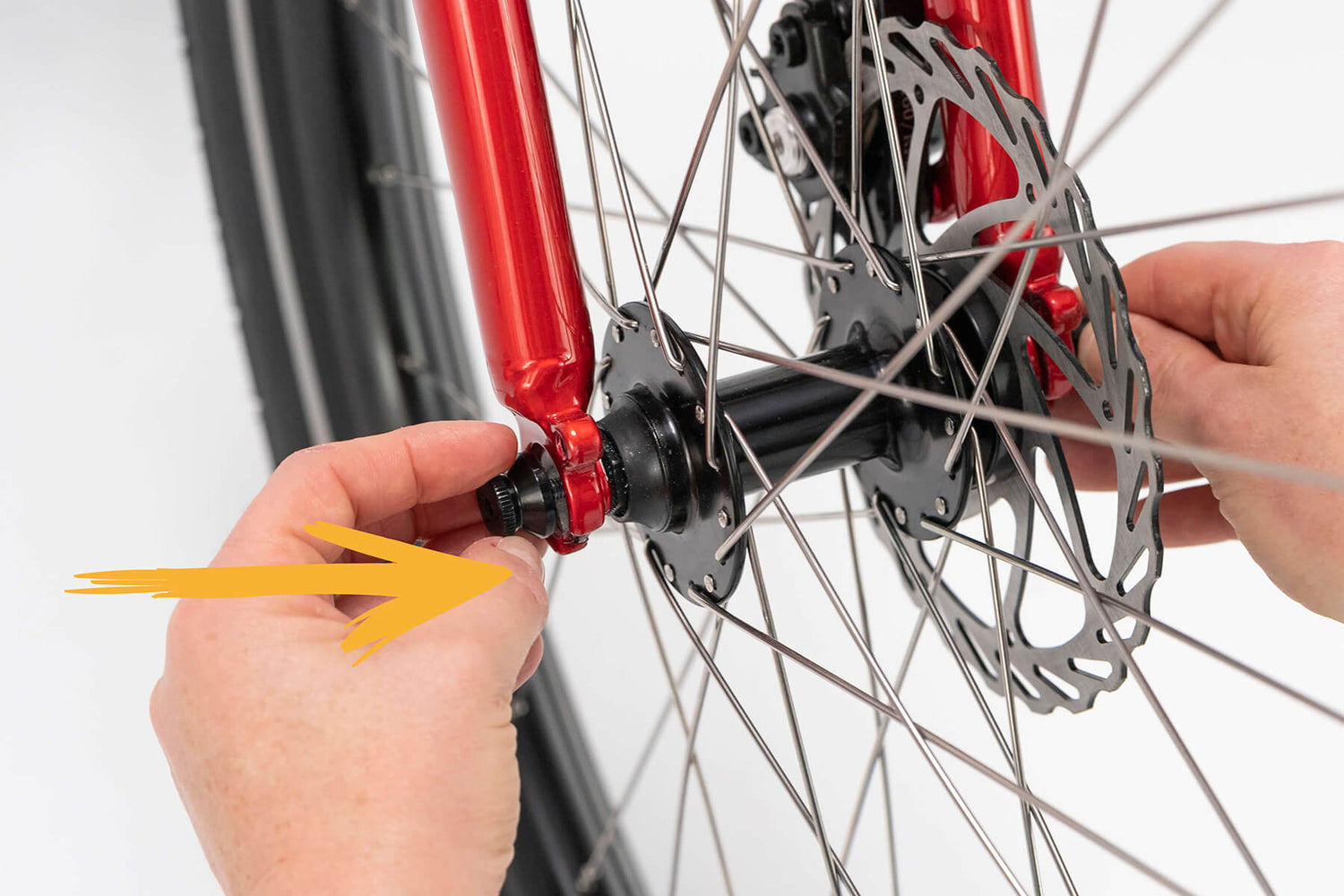
11. Turn the axle nut clockwise
until finger-tight.
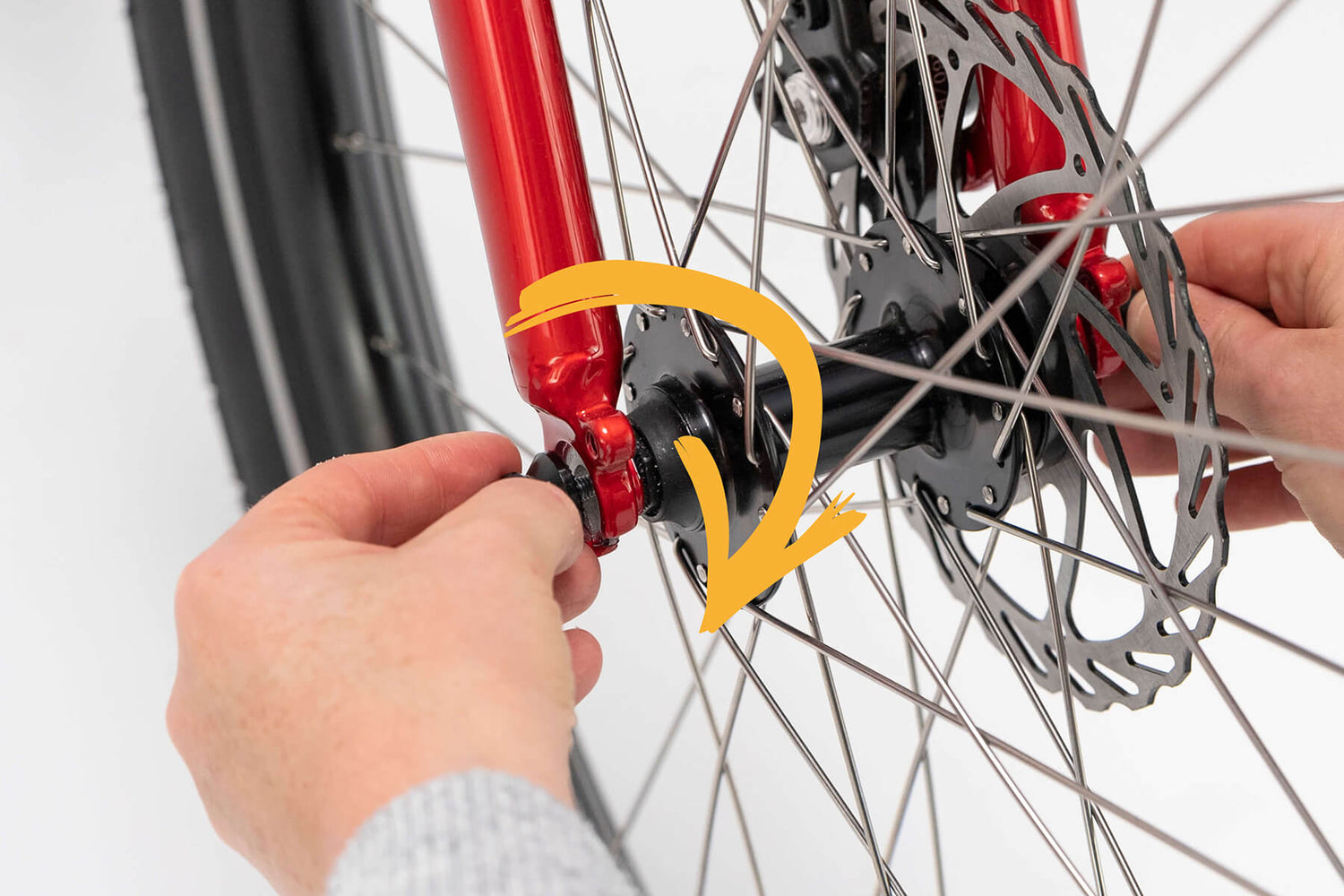
12. Locate the torque wrench. Remove the 4mm bit and install the 5mm bit.
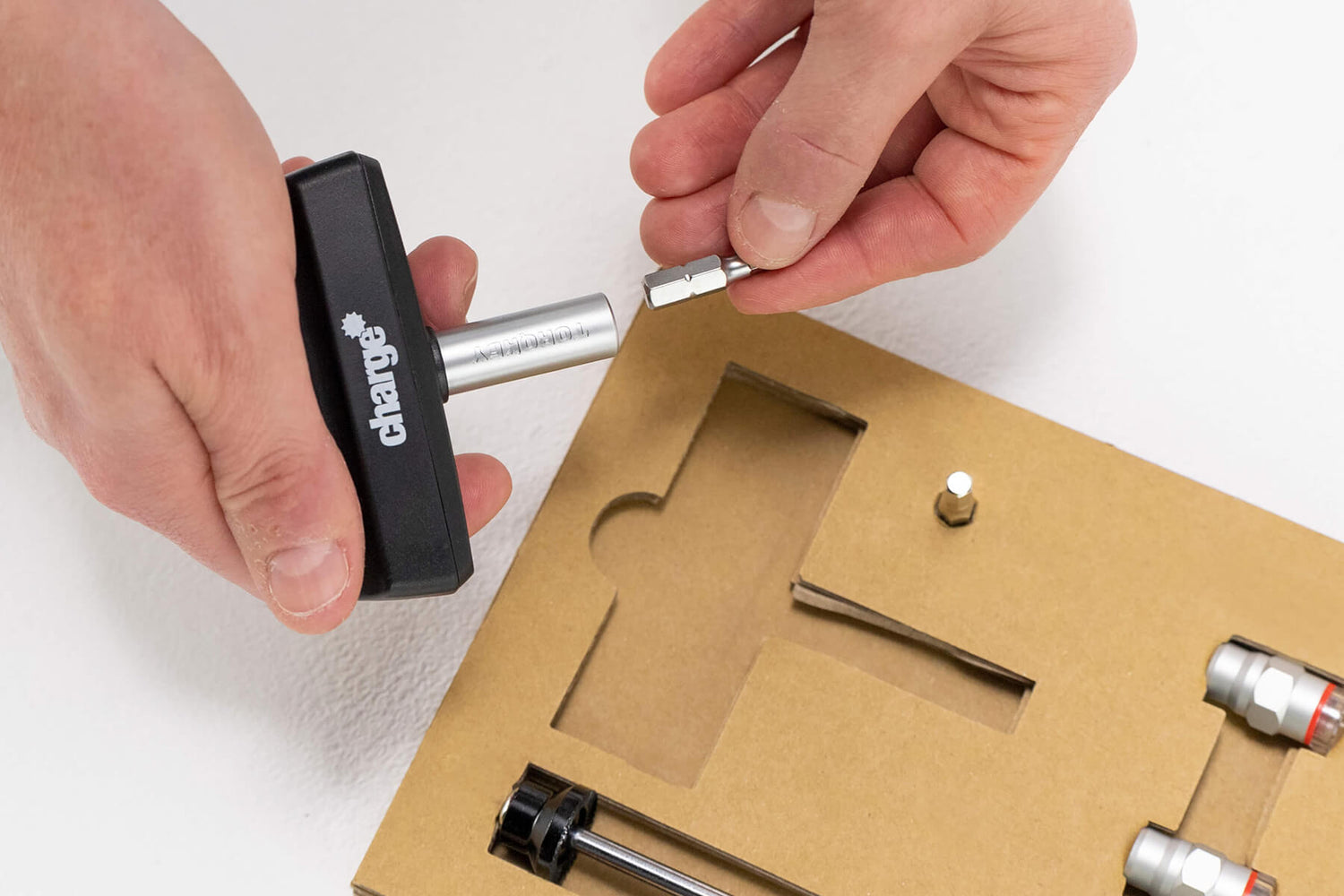
13. With your left hand, hold the bike upright and centered (perpendicular to the floor).
14. Push the frame down to ensure the fork ends are fully seated on the axle.
15. Continuing to hold the bike upright with one hand, use your free hand to insert the torque wrench into the axle on the brake disc side.
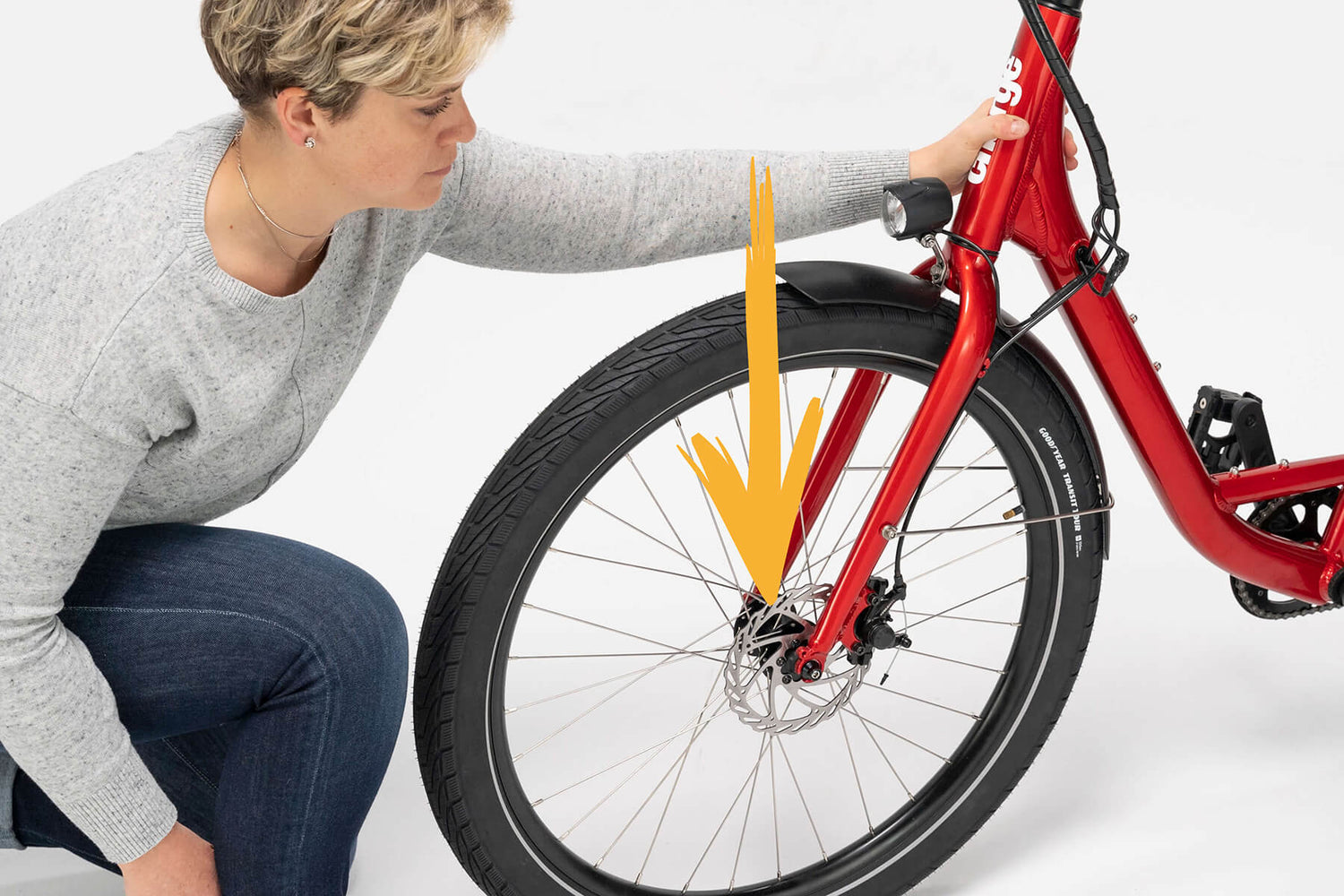
16. Turn the torque wrench clockwise until you hear and feel a click. This indicates the correct torque has been achieved.
NOTE: You may need to apply a good deal of pressure to hear and feel the click.
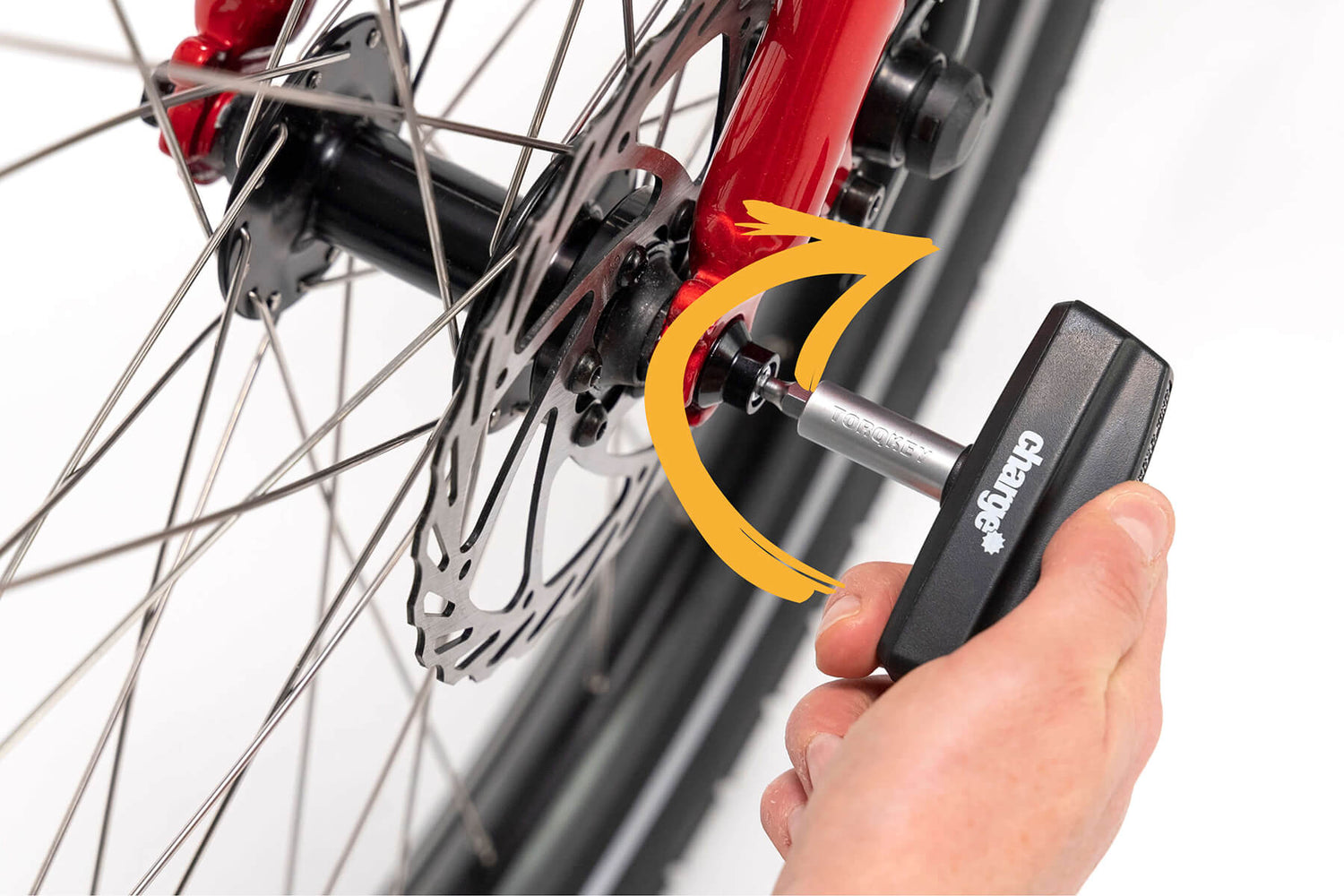
3: Flip Down the Pedals
1. Flip each pedal down (or up) until it clicks.
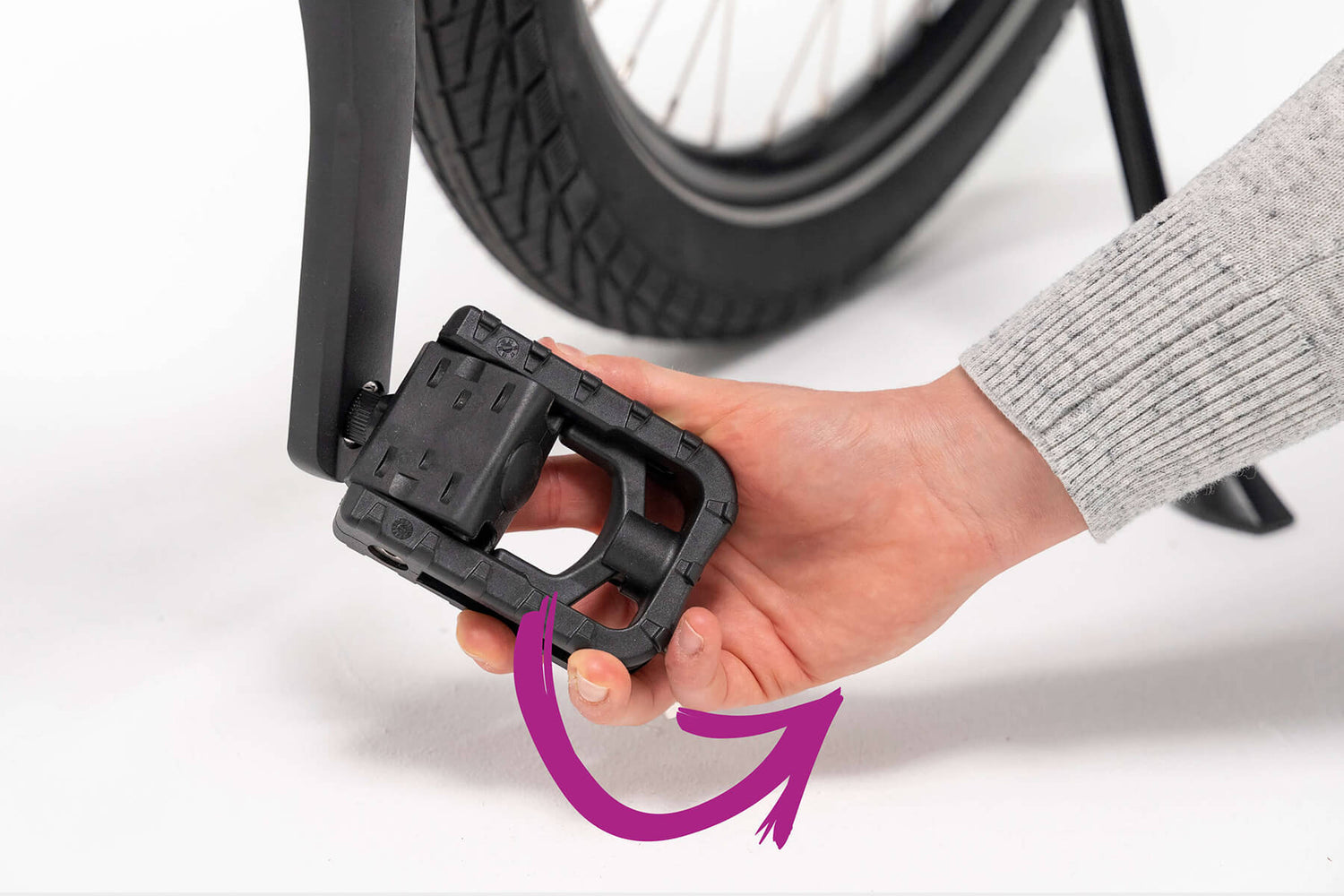
2. Pull lever to reverse this process when folding the pedals flat for easy storage.
NOTE: You can always flip up the pedals by pulling on the lever with your fingers as you move the pedal to the upright position.
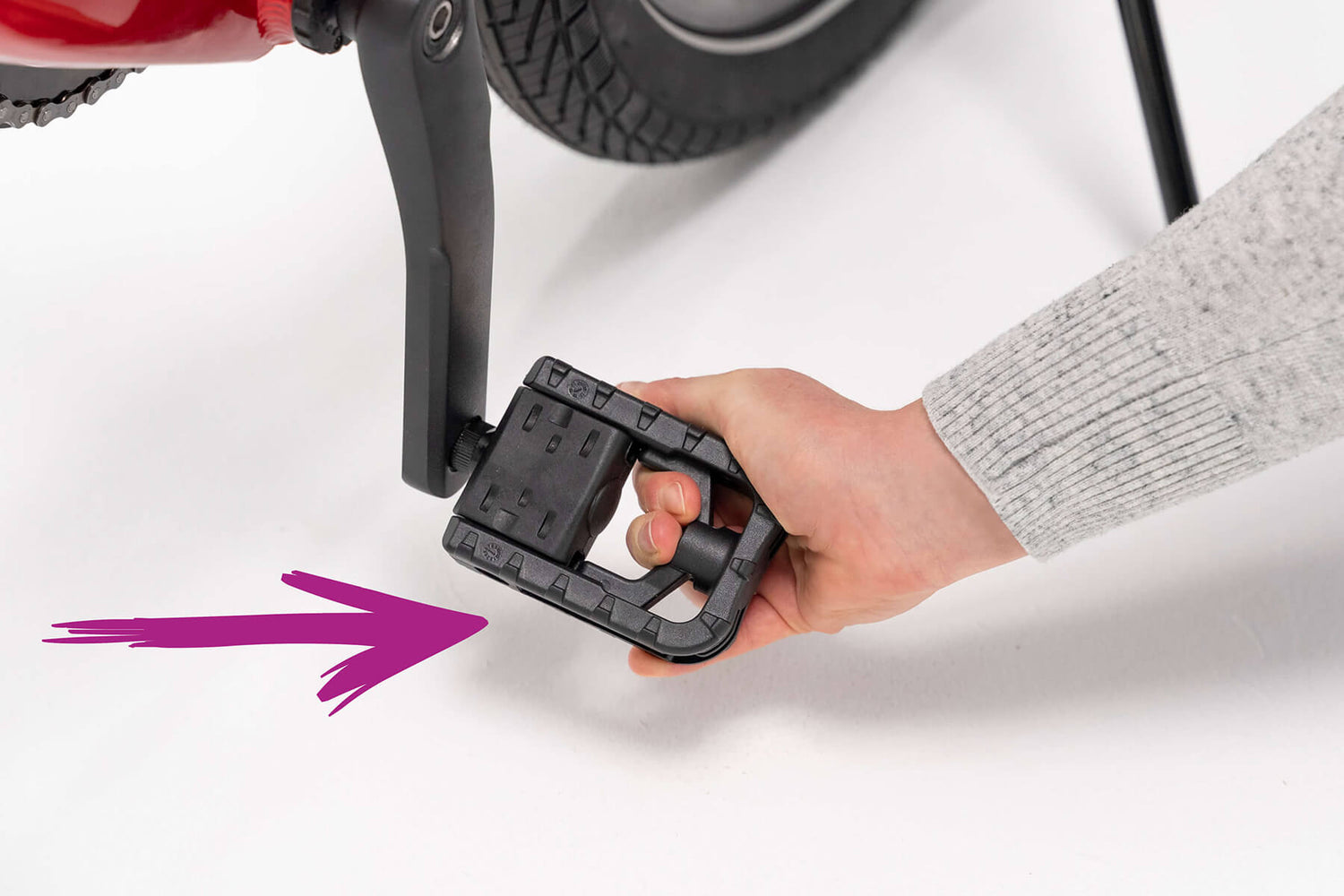
Step 4: Adjust Seat Height
1. Using the torque wrench, loosen the seat post clamp bolt (turning counterclockwise) until the seat post can move.
NOTE: You do not need to remove the bolt from the clamp.
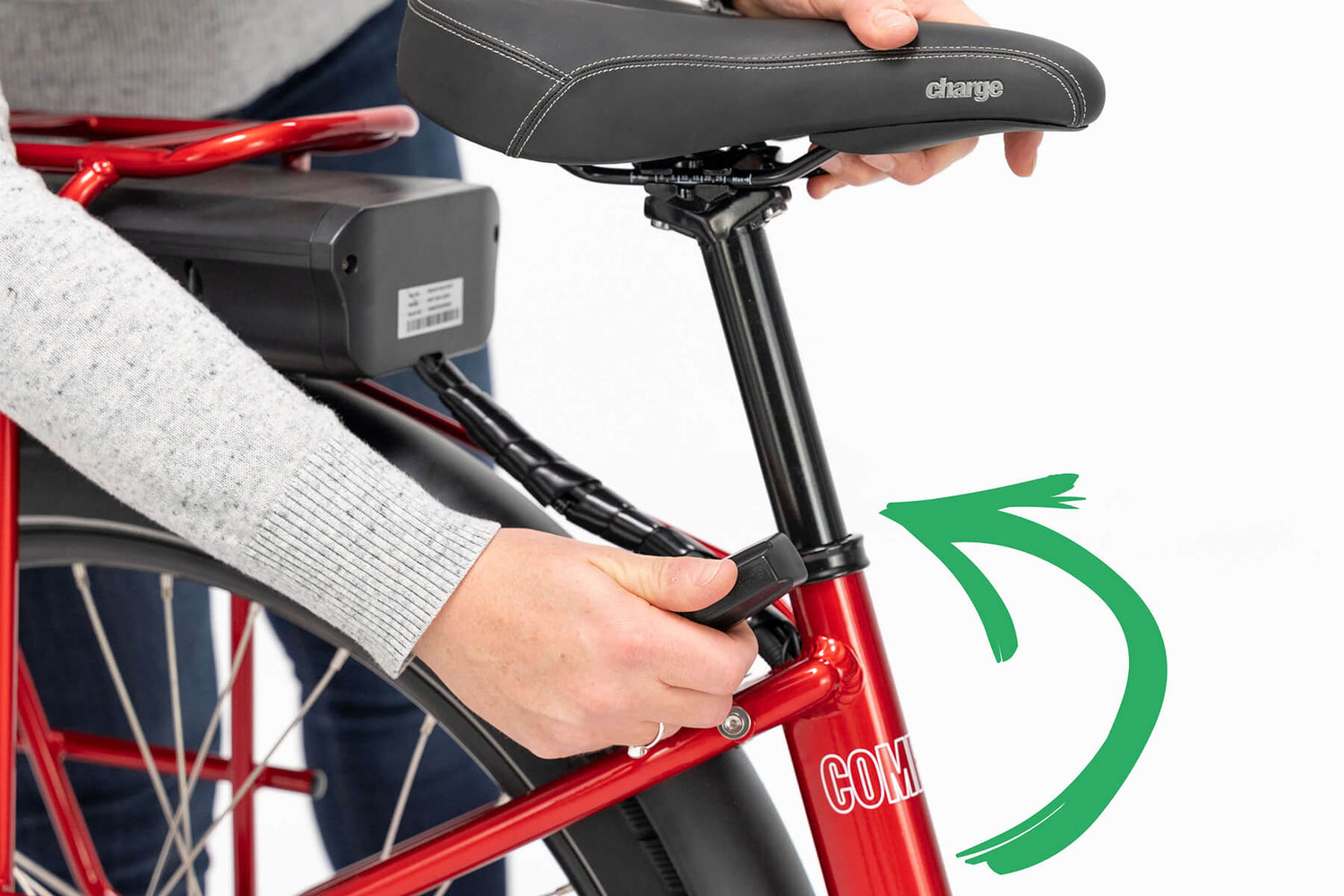
2. Slide the seat to your desired position. See Diagram B for guidance on finding the right seat height.
WARNING: Do not raise the seat above minimum insertion line marked on the seat post.

3. To find a comfortable seat height: While sitting on the bike, move one of the pedals to the 6 o’clock position, and place your heel on the pedal.
Adjust the seat higher or lower until your knee is just slightly bent without having to shift around on the seat.
NOTE: Do not leave kickstand down when sitting on the bike. The kickstand is not designed to hold up the weight of a rider.

4. Ensure the seat nose is in-line with the bike frame.
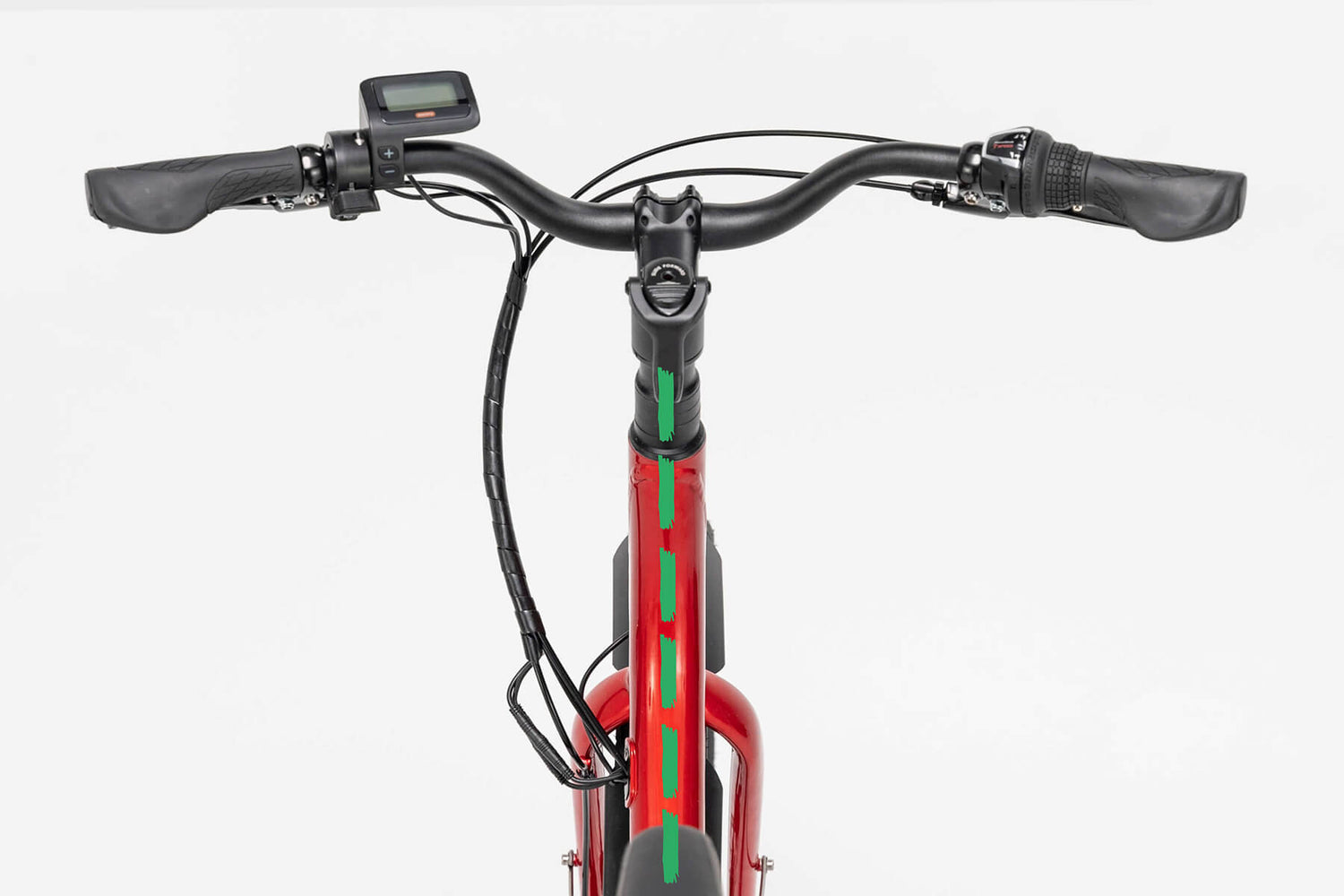
5. Secure the seat by turning the bolt clockwise until you hear and feel the torque wrench click.
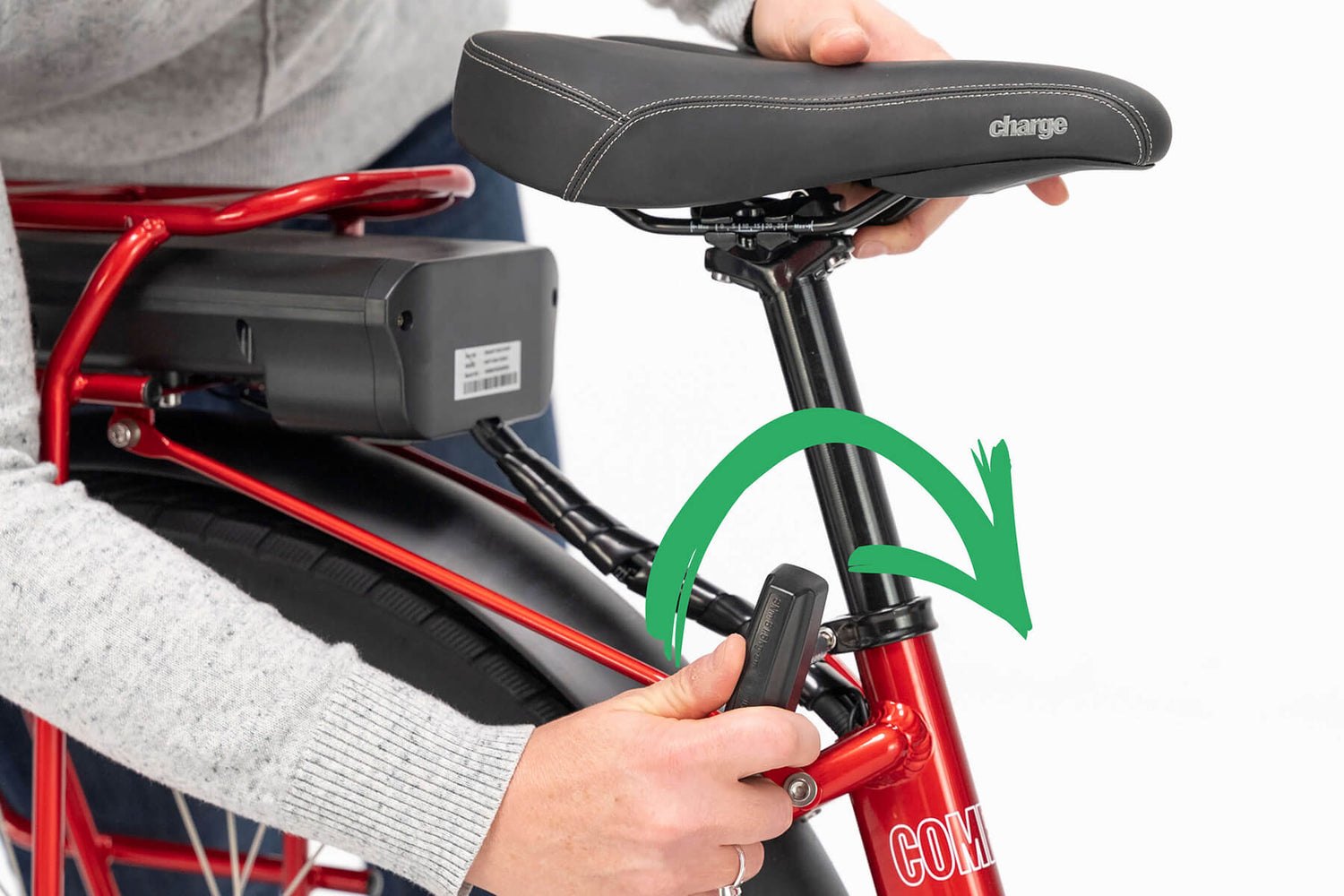
5. The finishing touch
Charge Bikes feature a valve cap sensor, so you always know when it’s time to add air. The sensors are included in your parts box. Simply screw the sensors onto the valve stems to quickly verify air pressure.
Green is good to go
Red means add some air
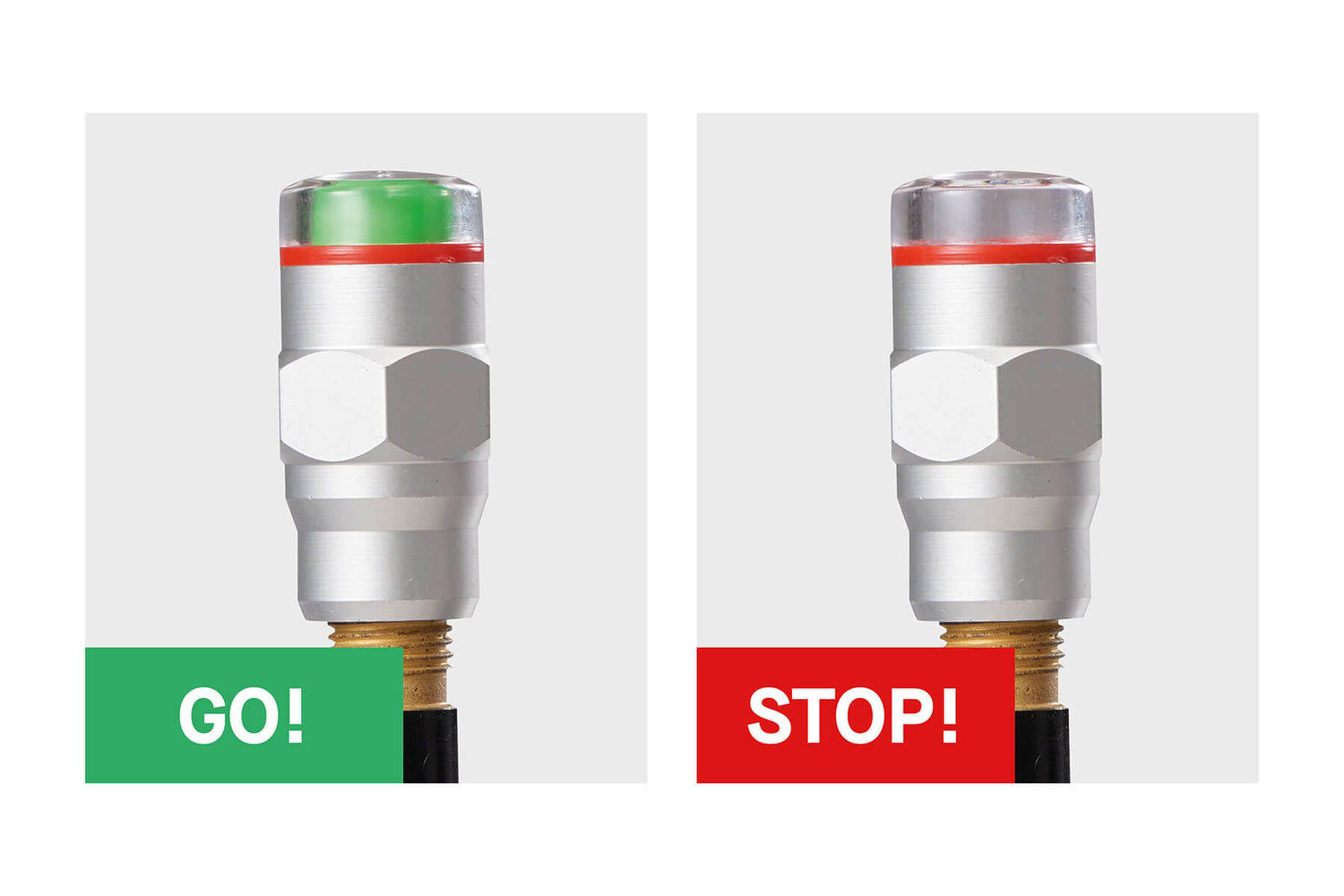
Register your bike
Your new Charge Bike is now assembled.
Before going for your first ride, review the Assembly Checklist and the Pre-Ride Checklist in your Charge Bicycle Owner’s Manual
Register Your Bike
Register your bike and activate your warranty